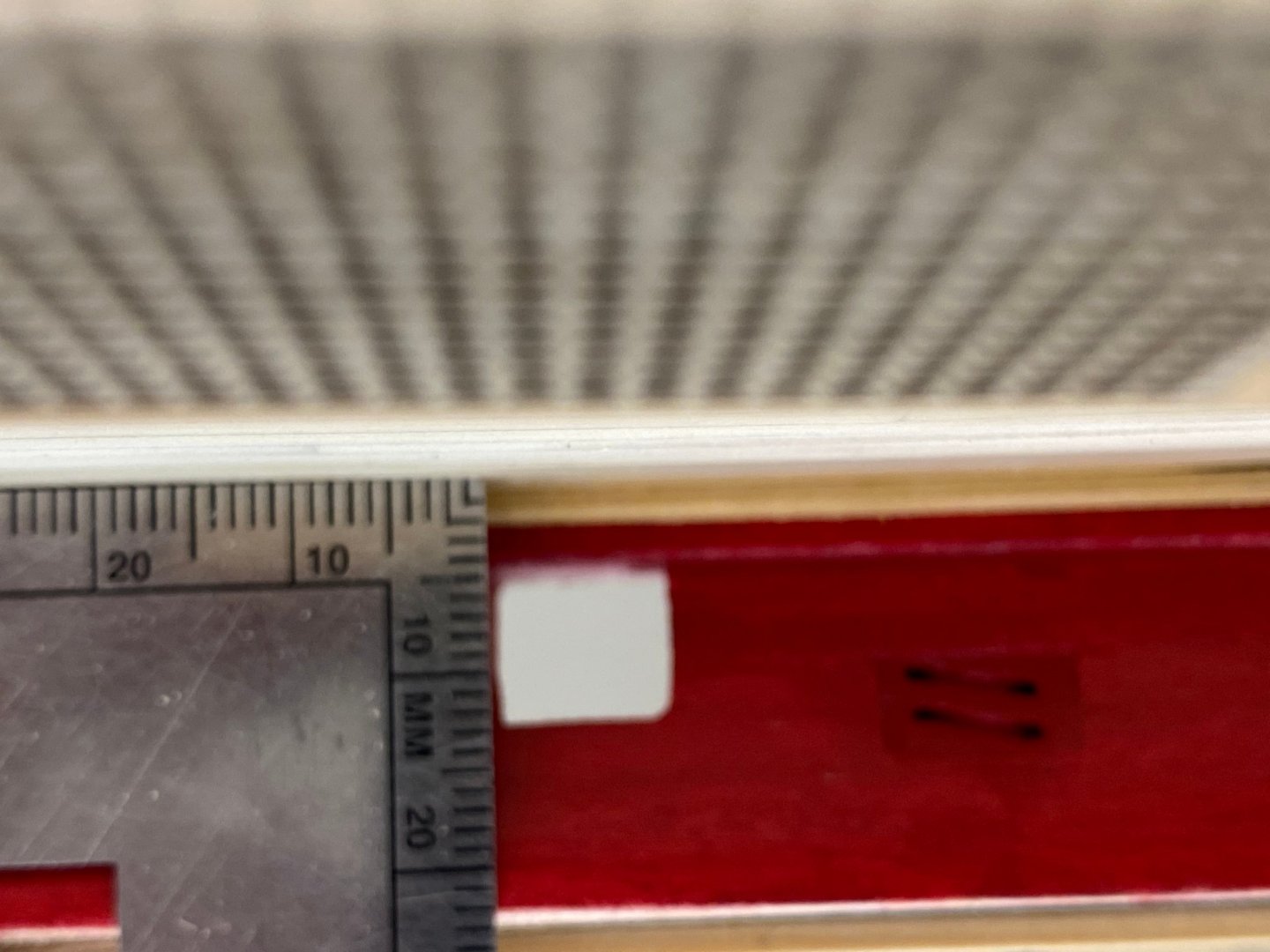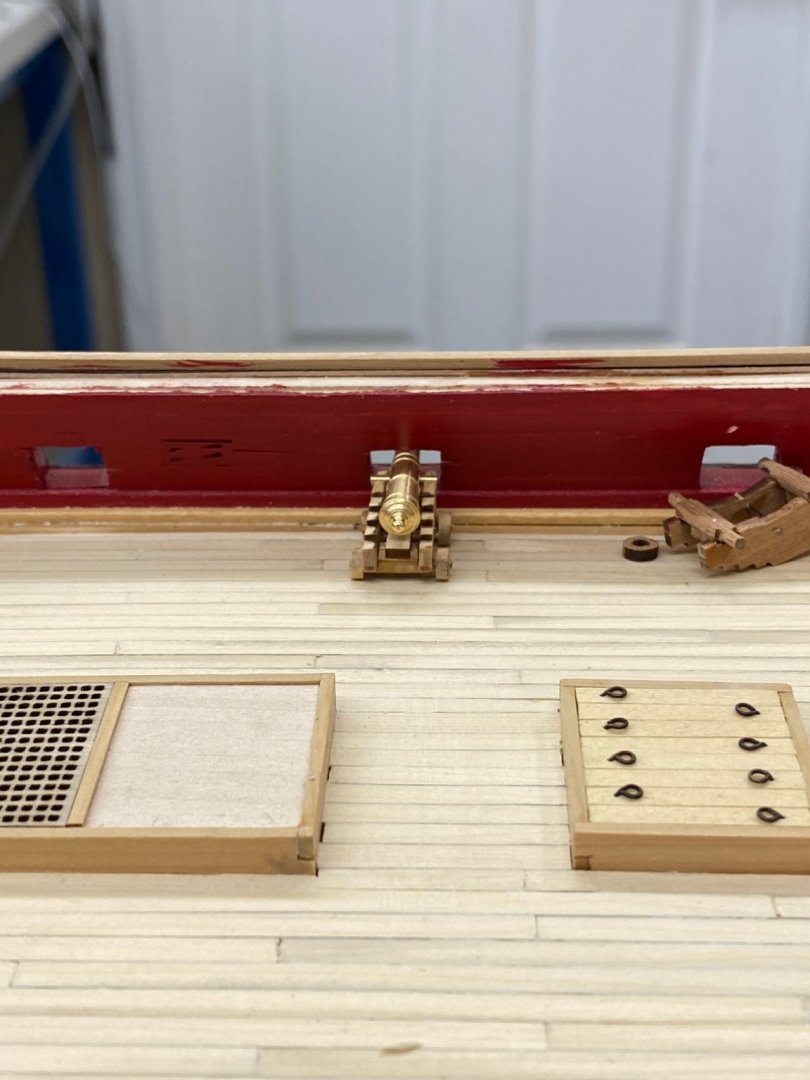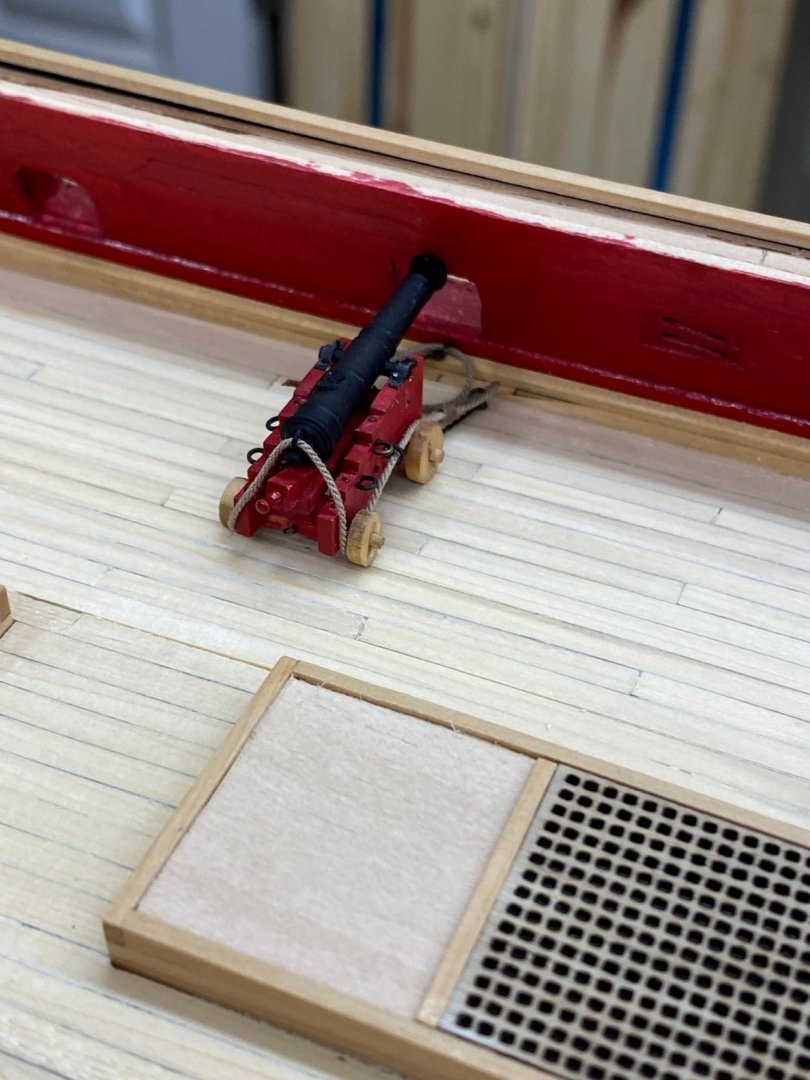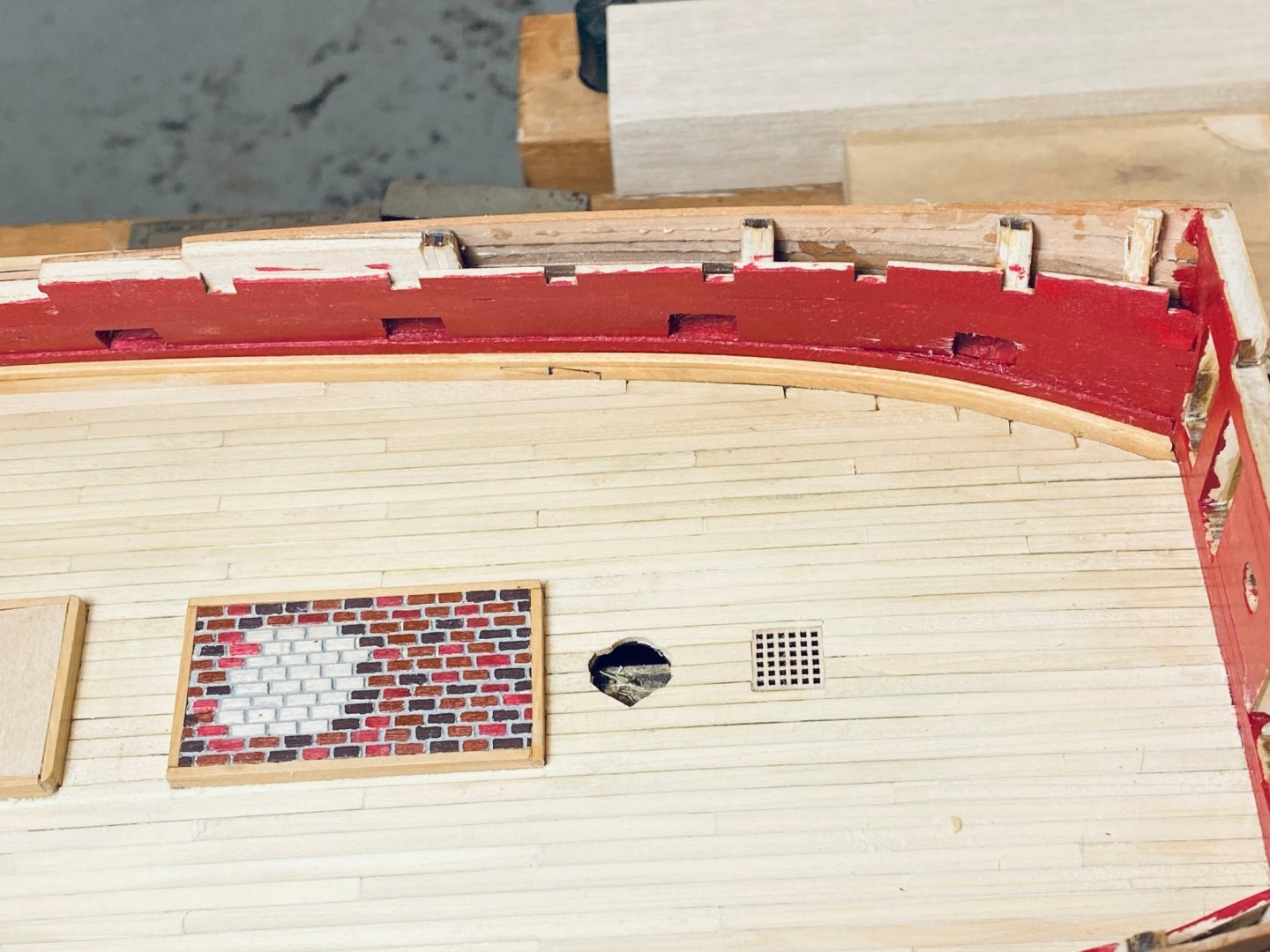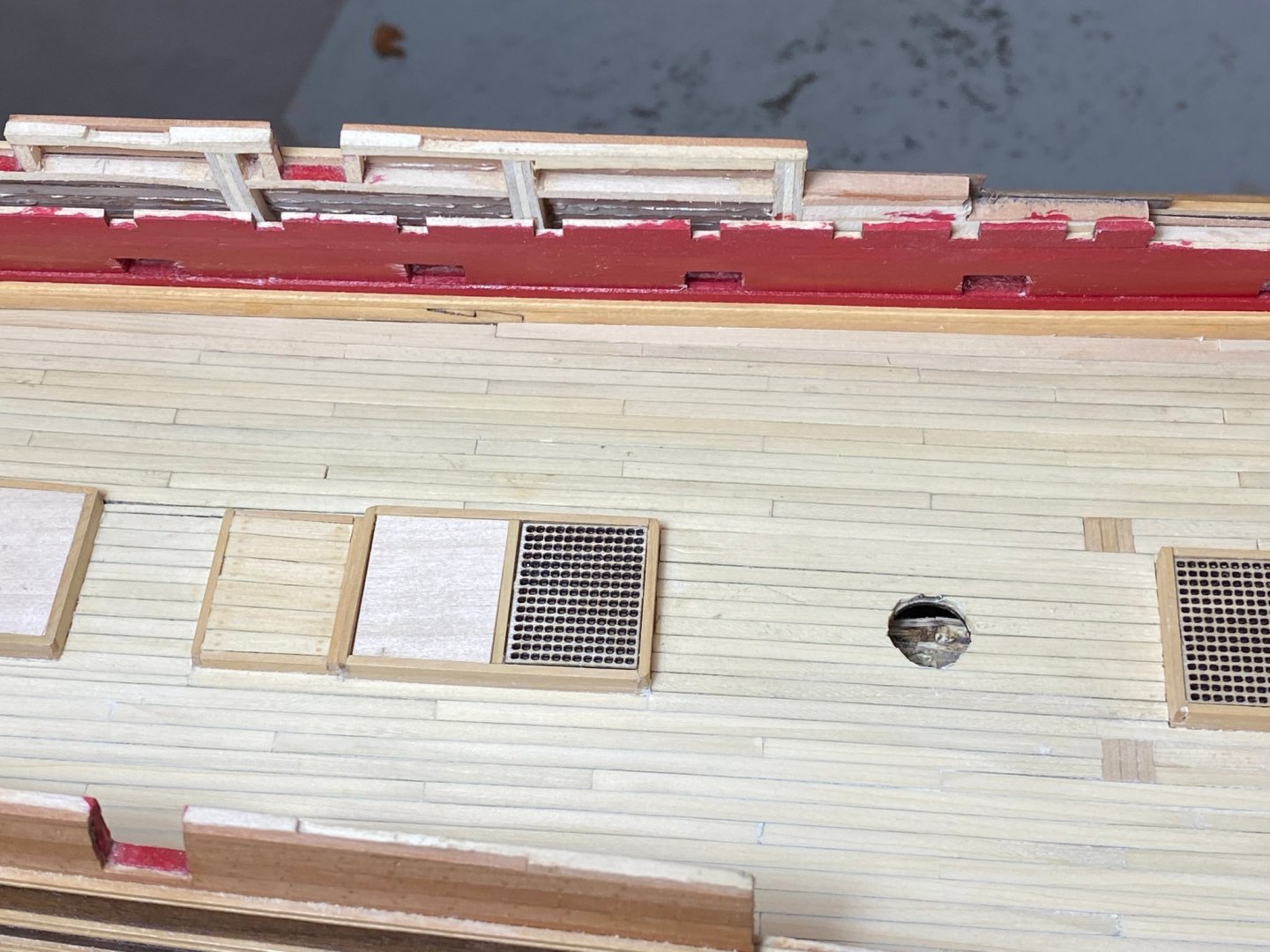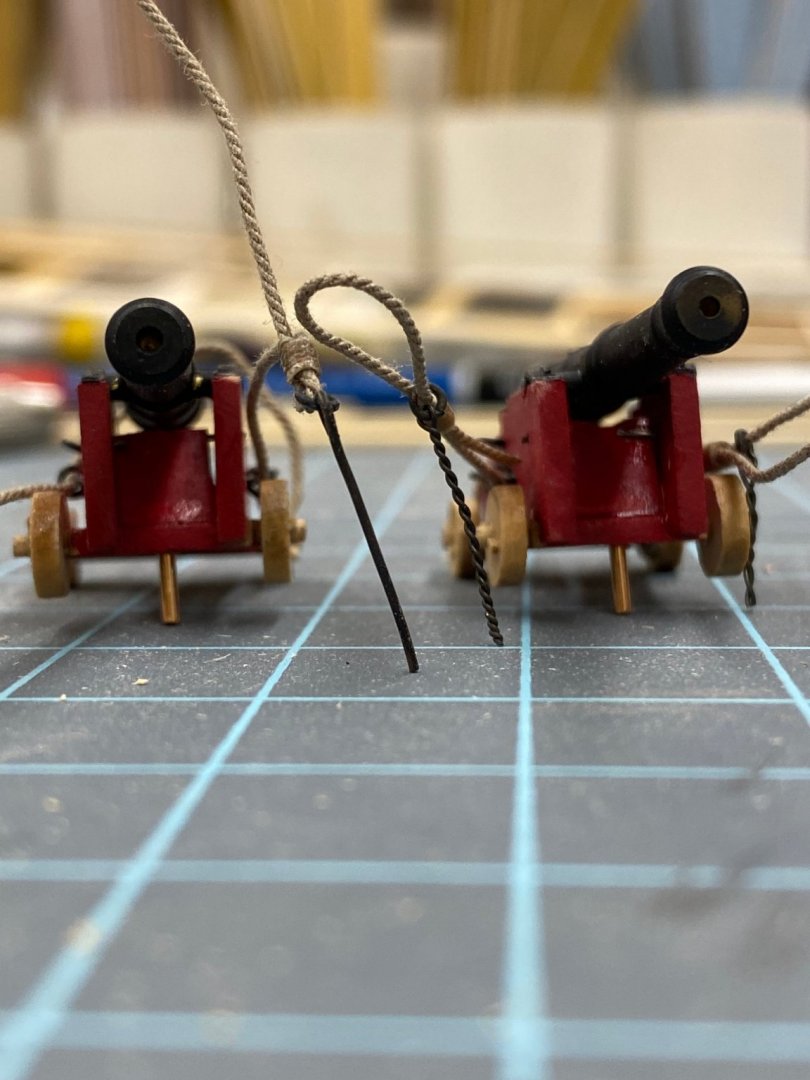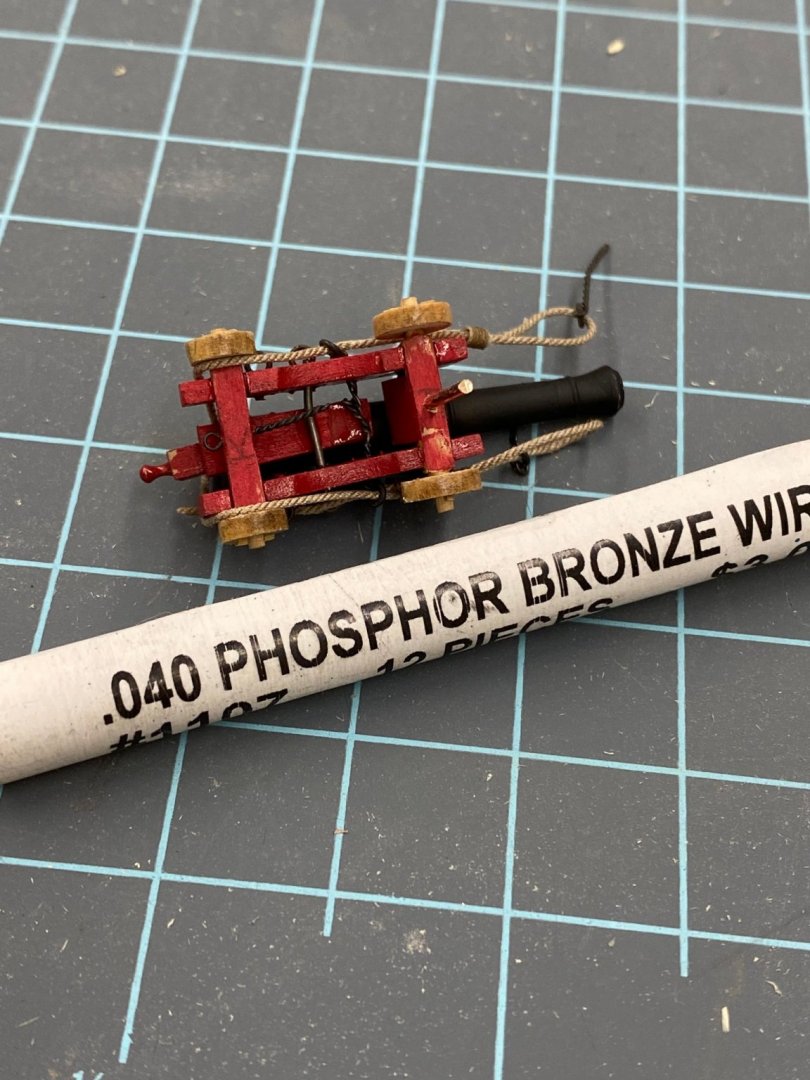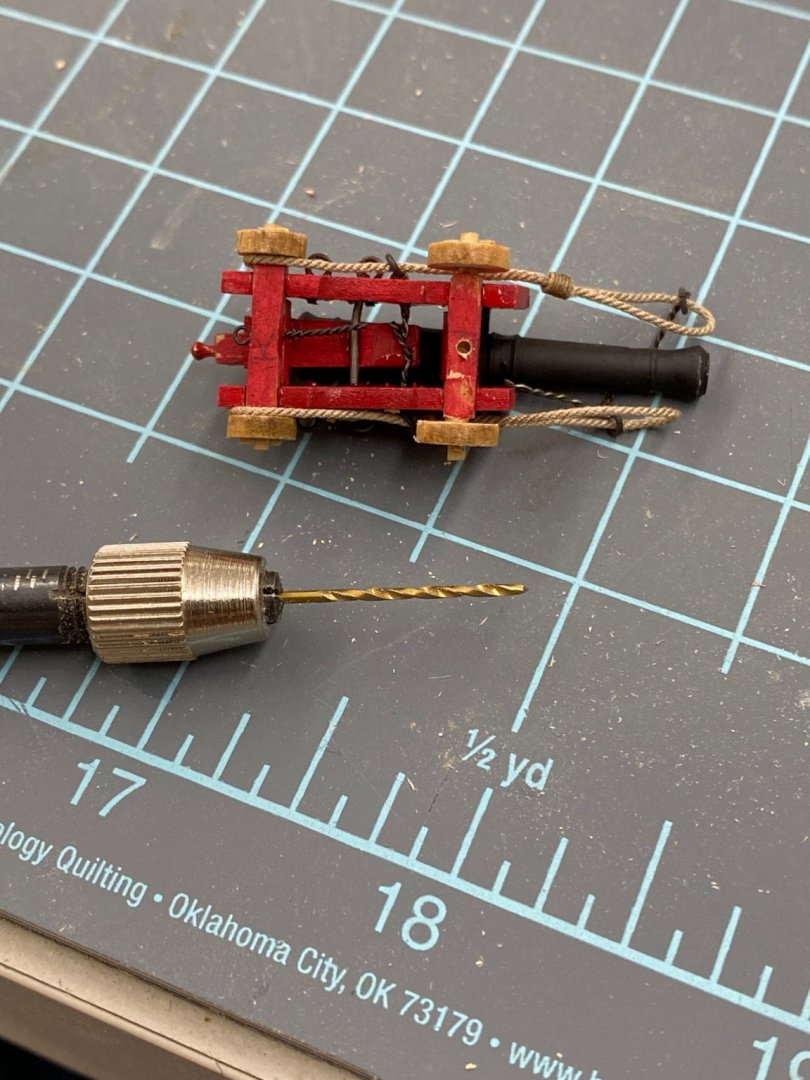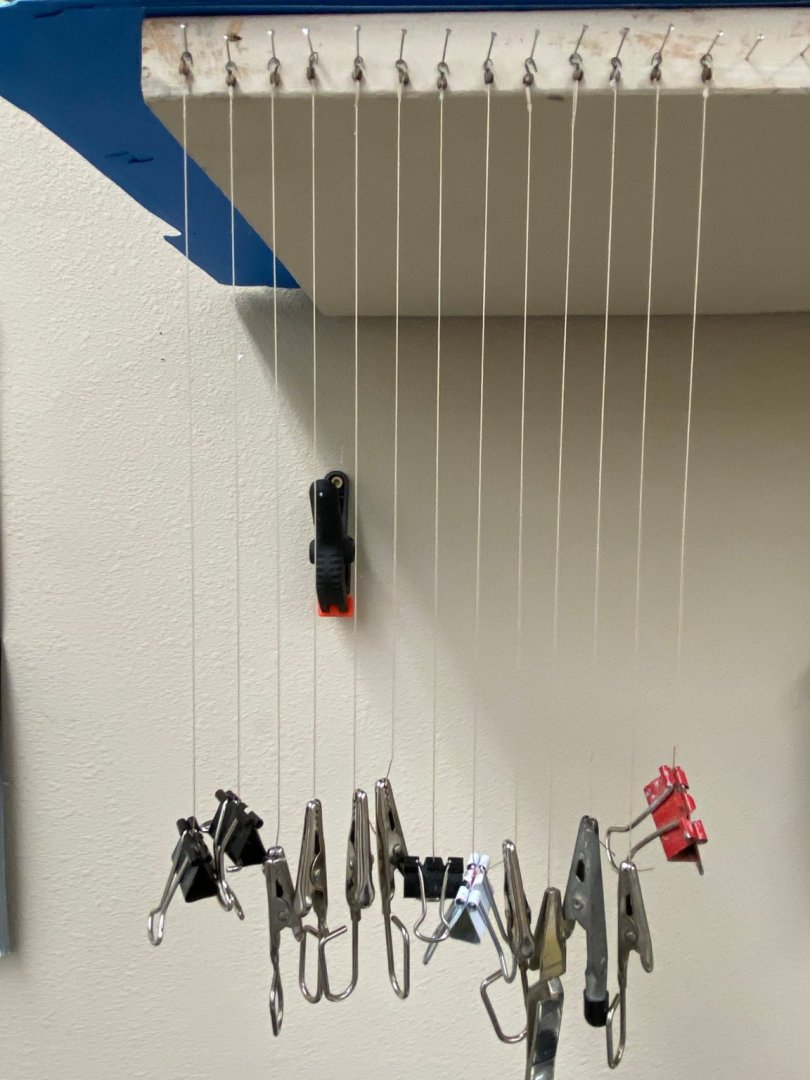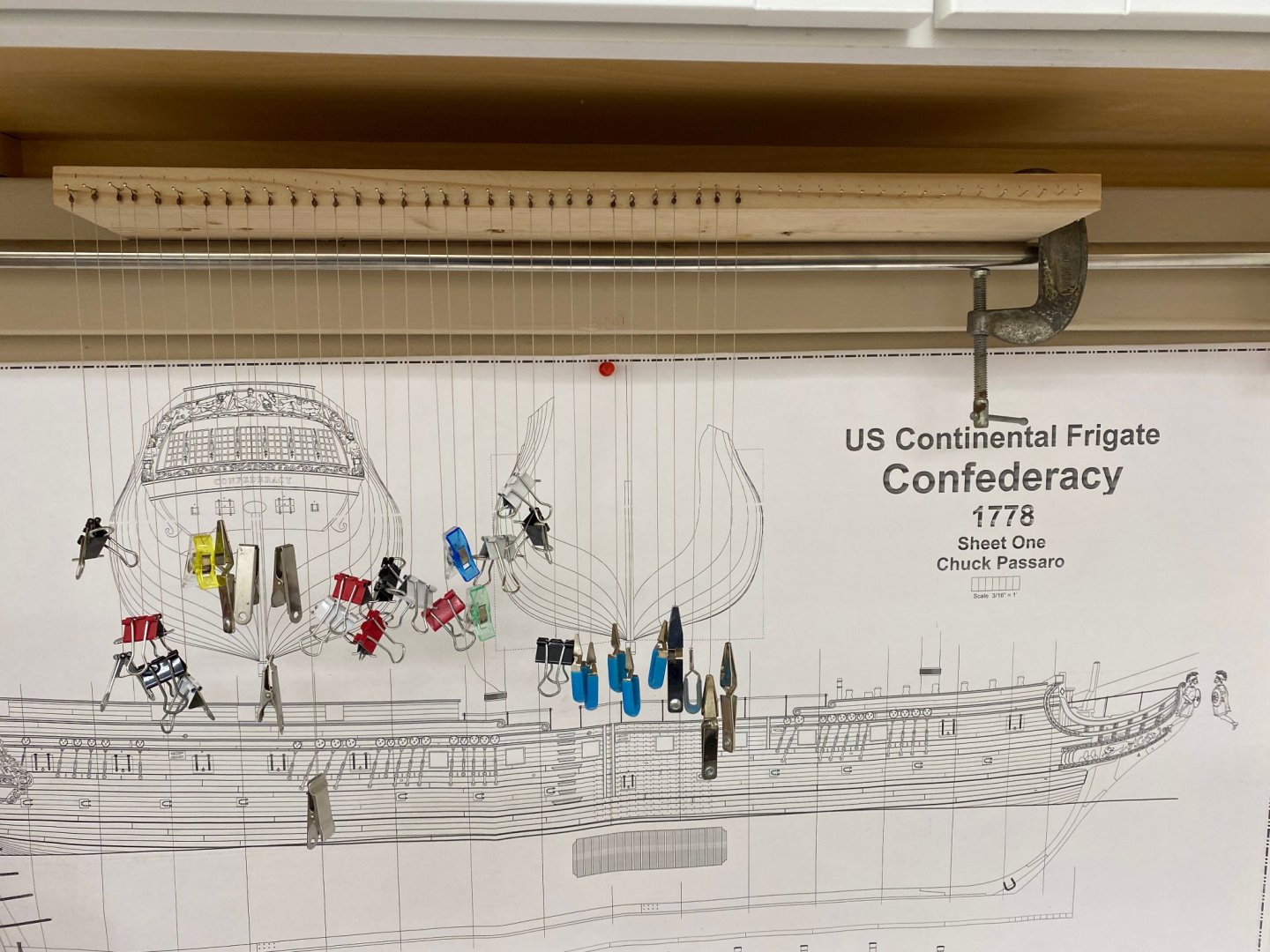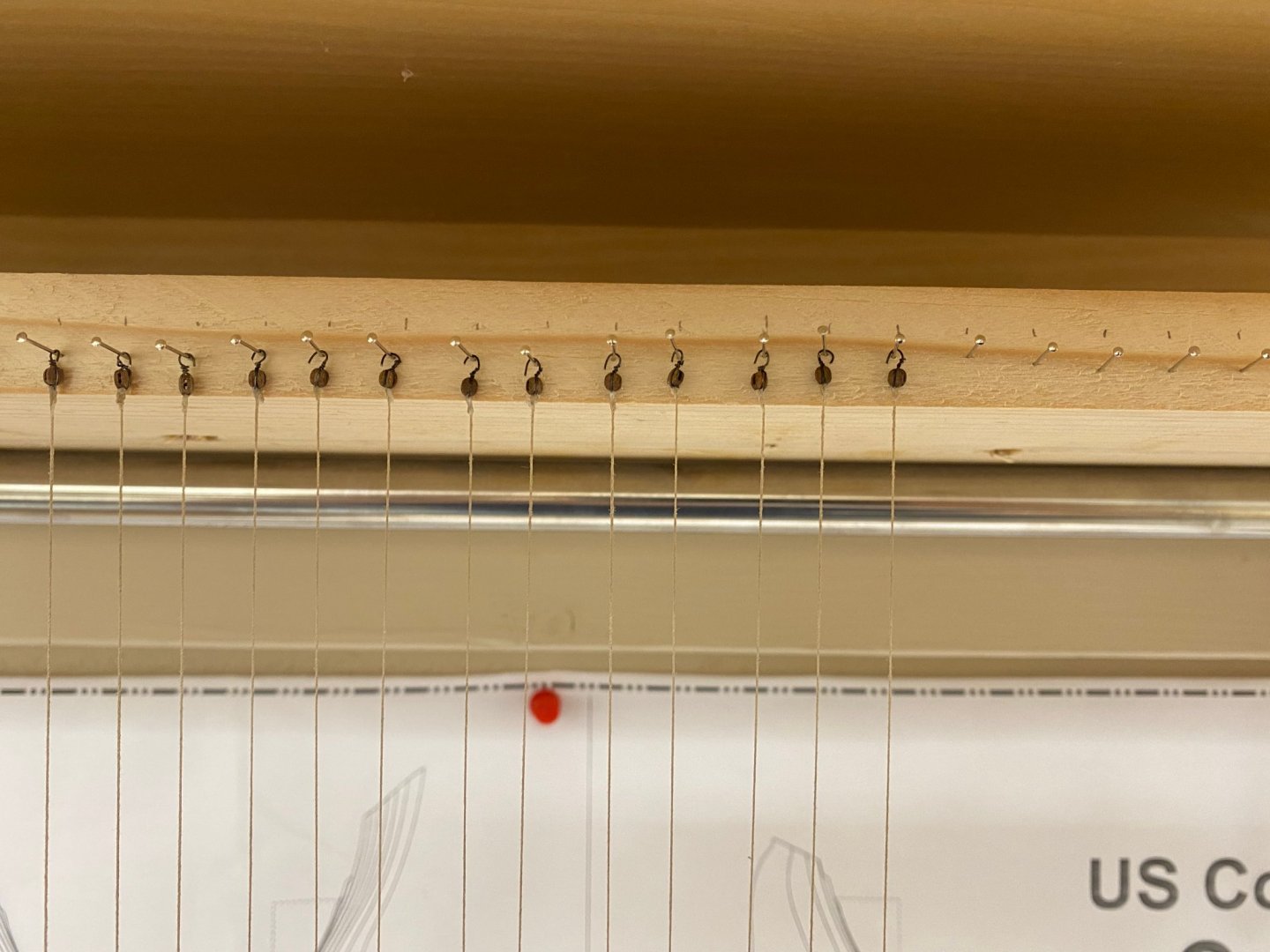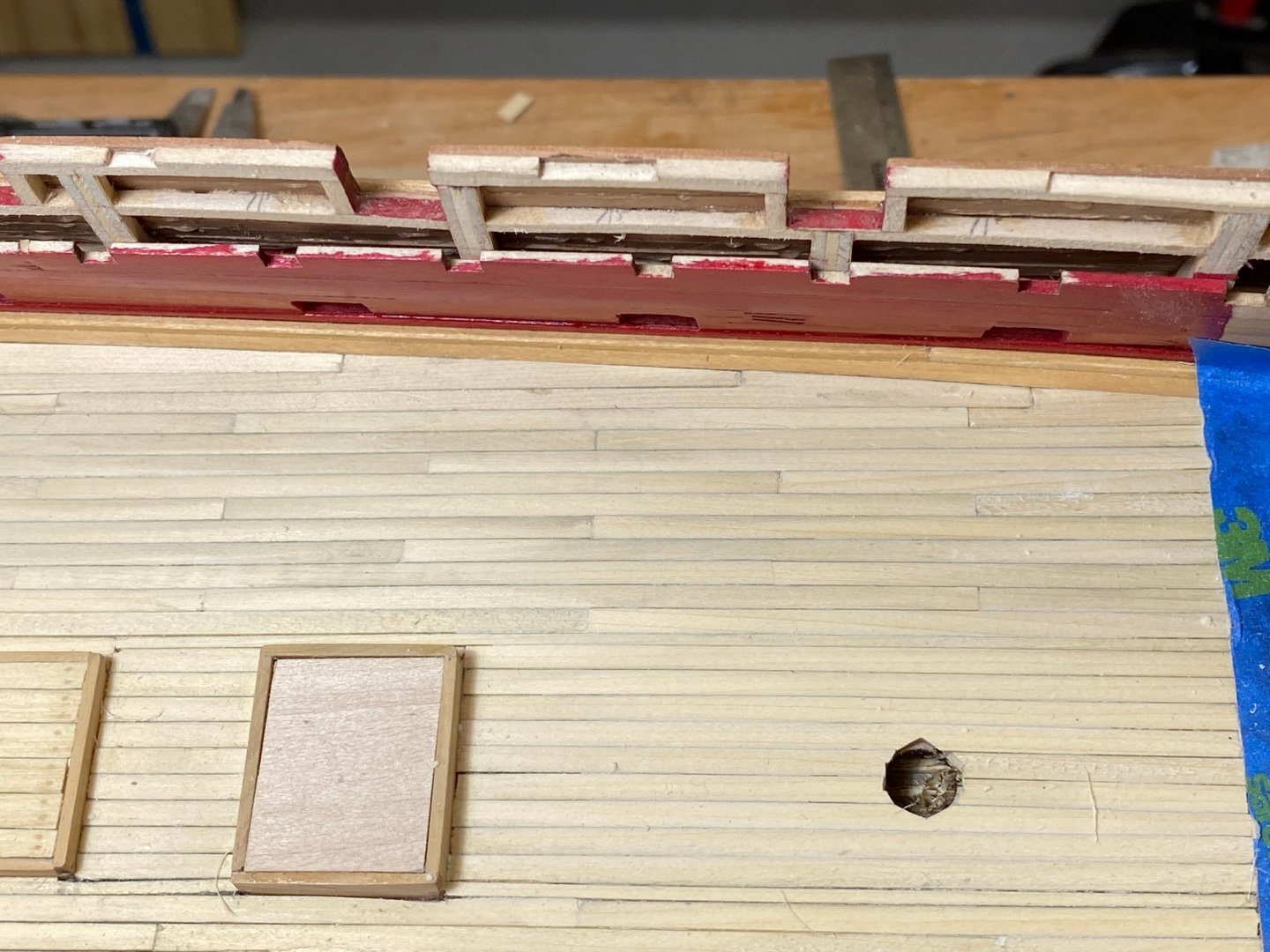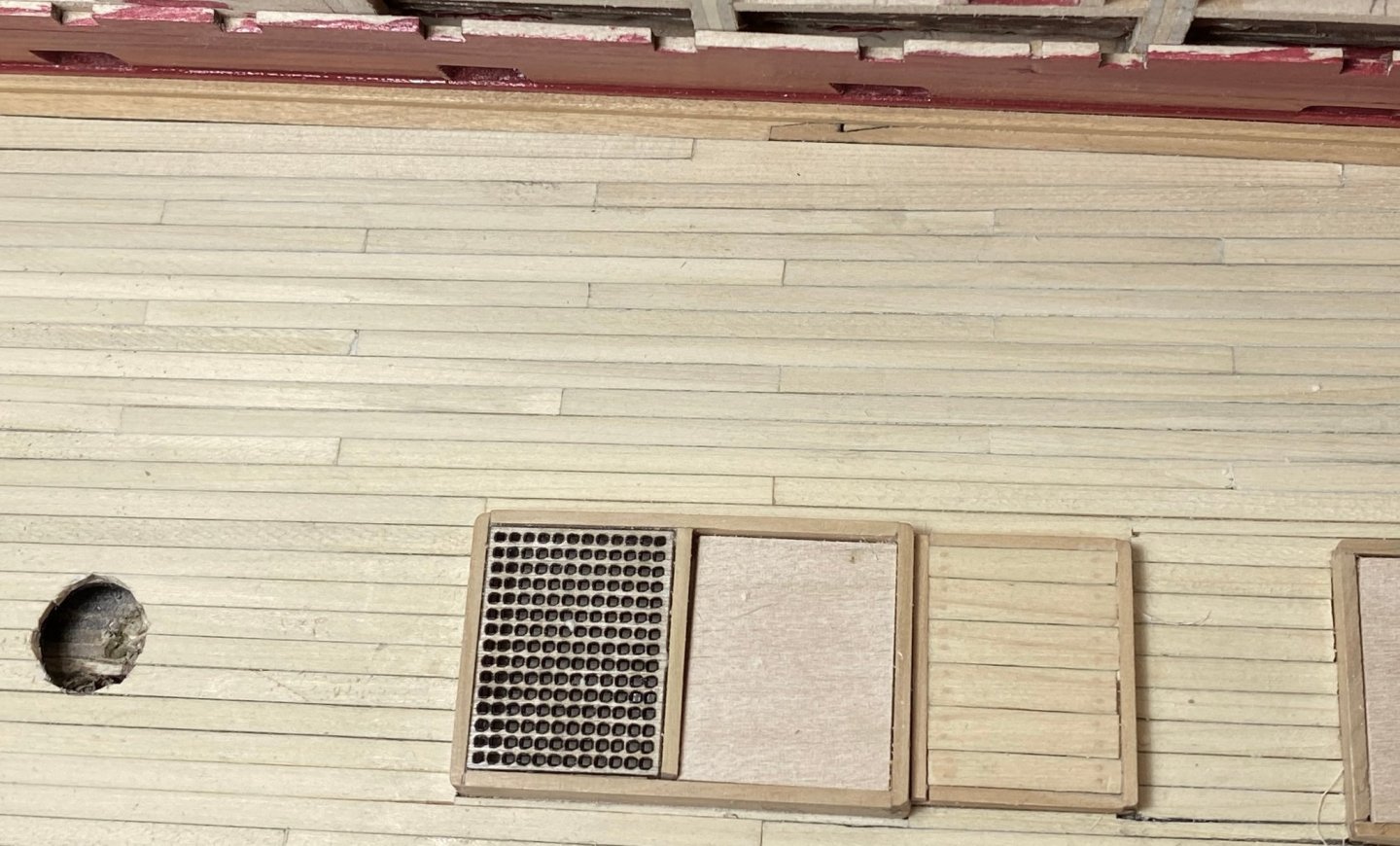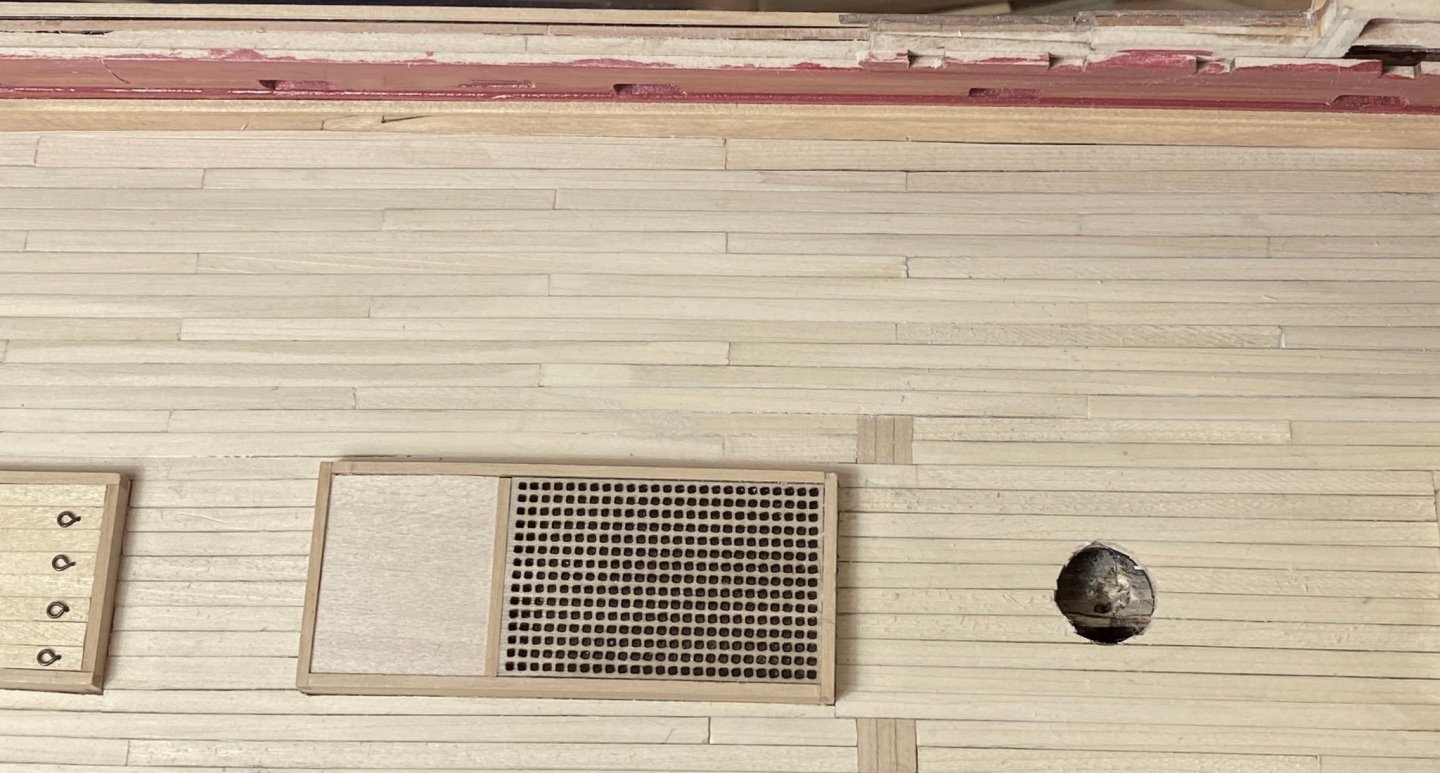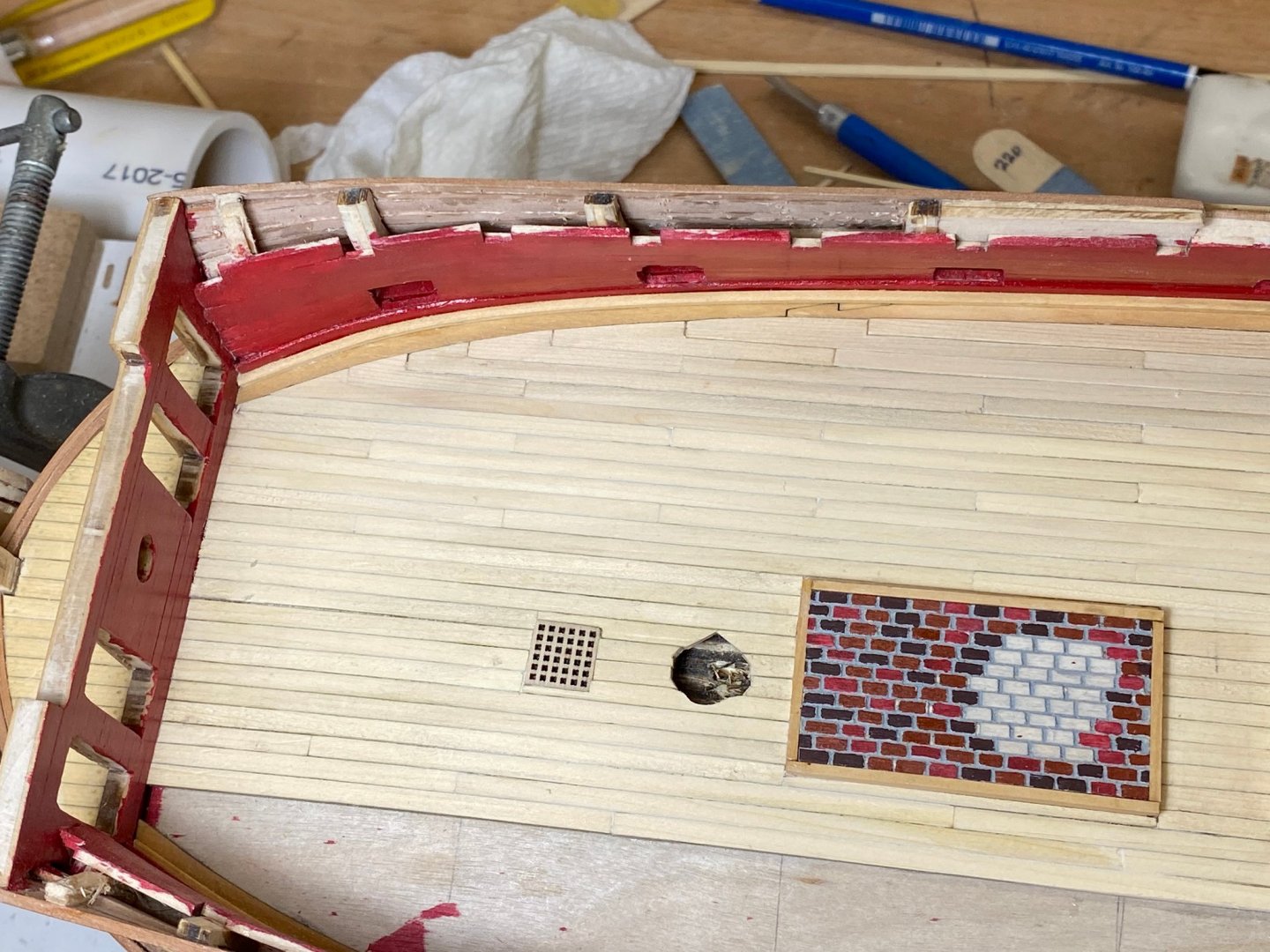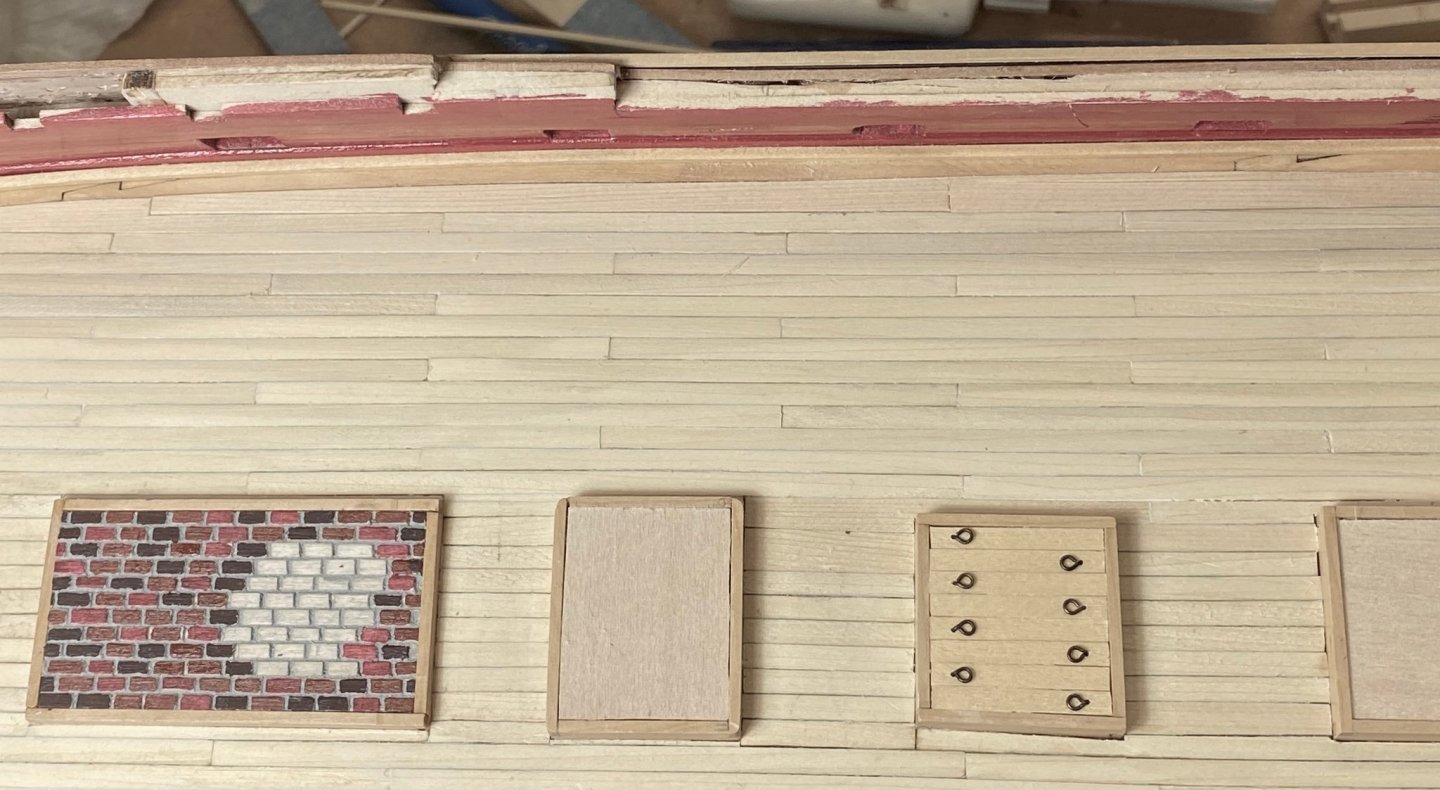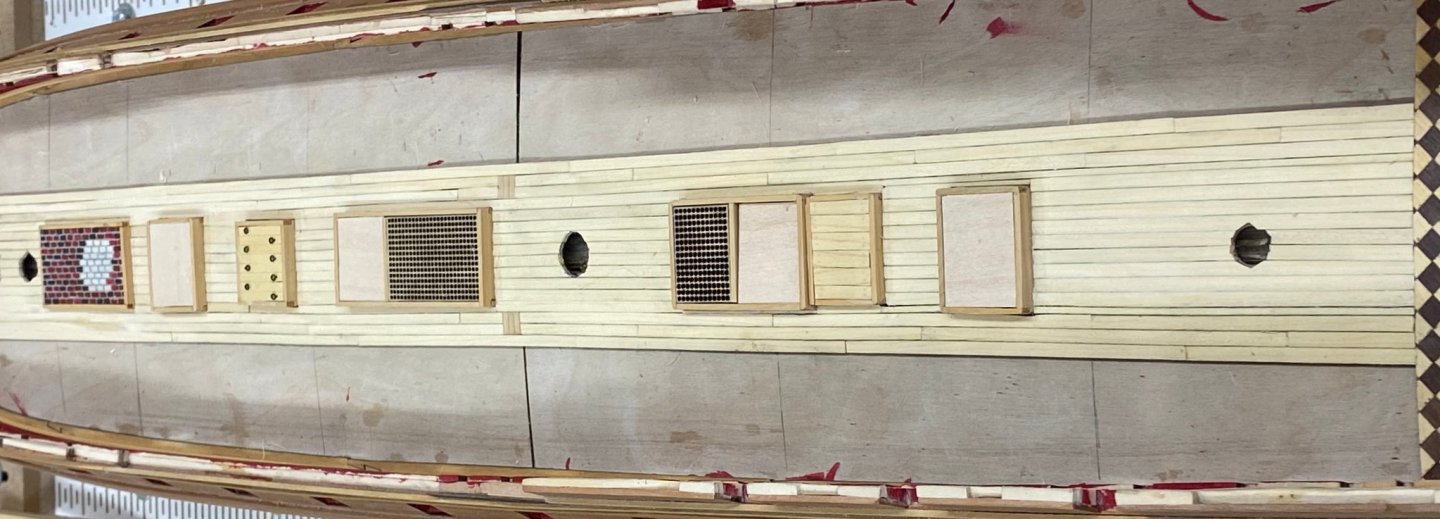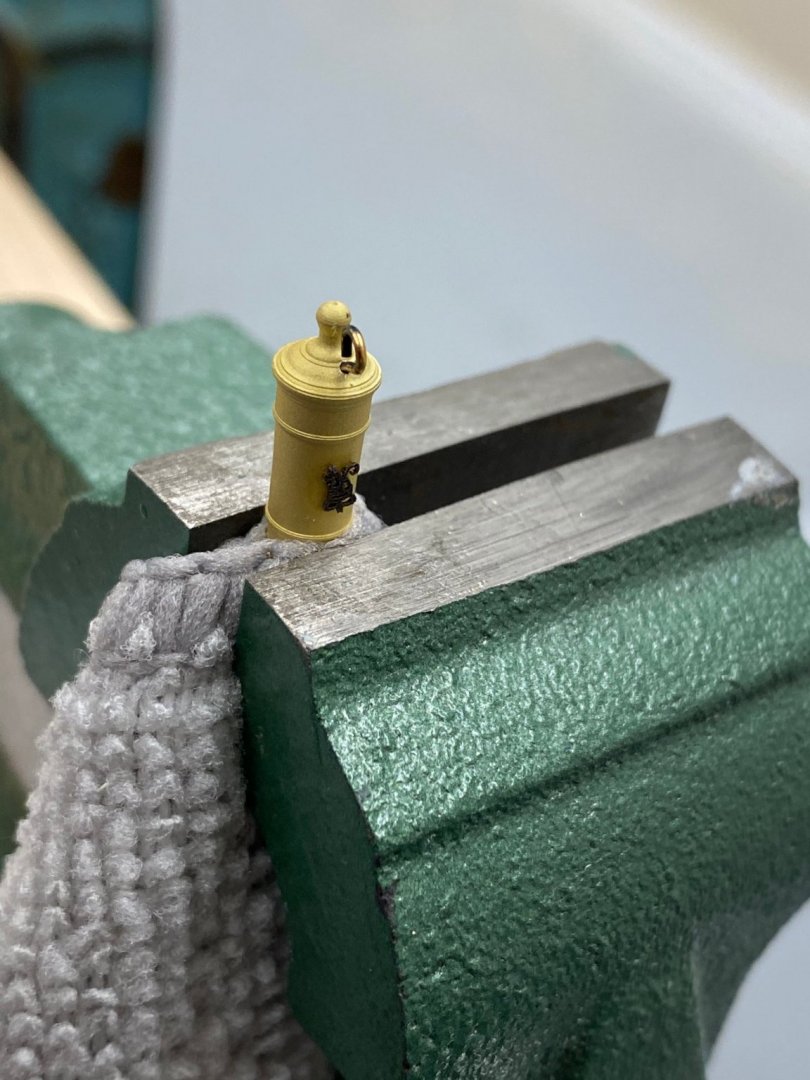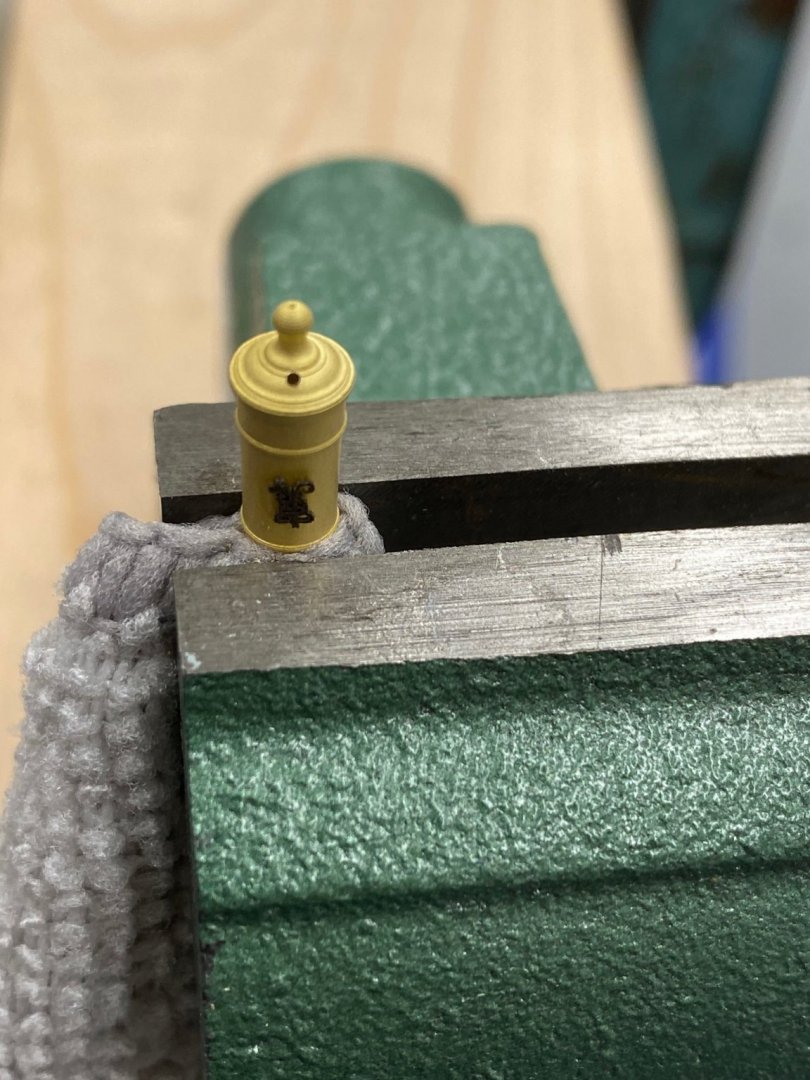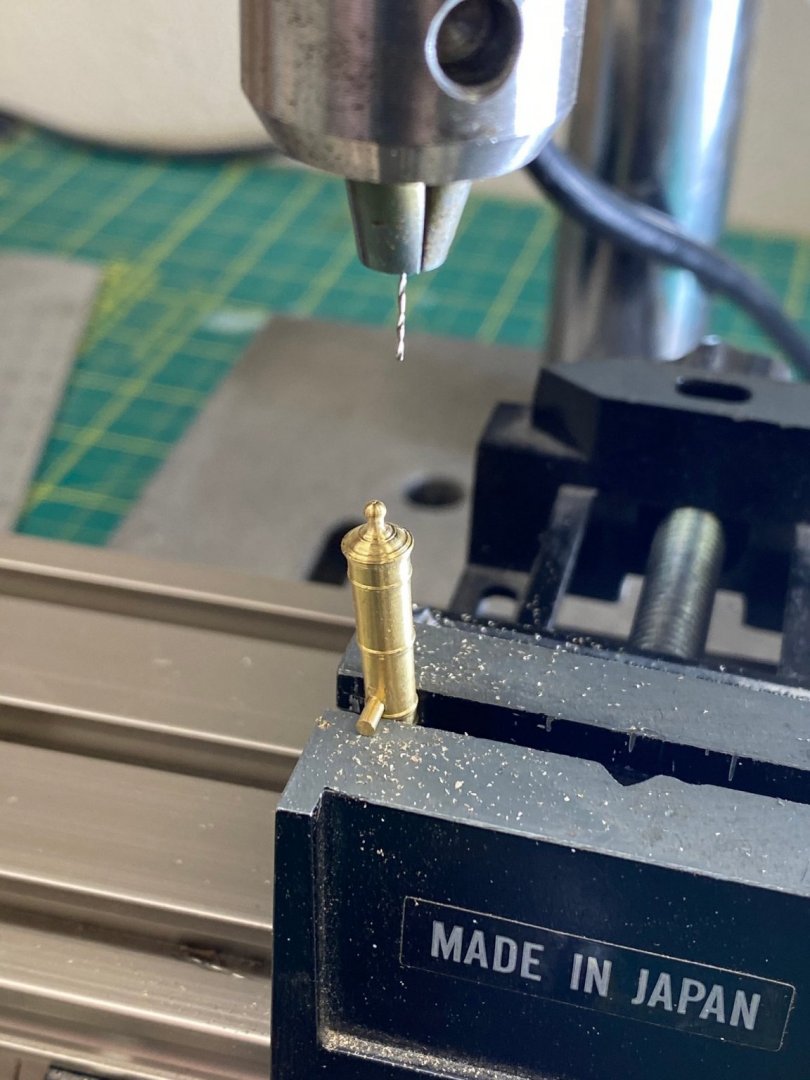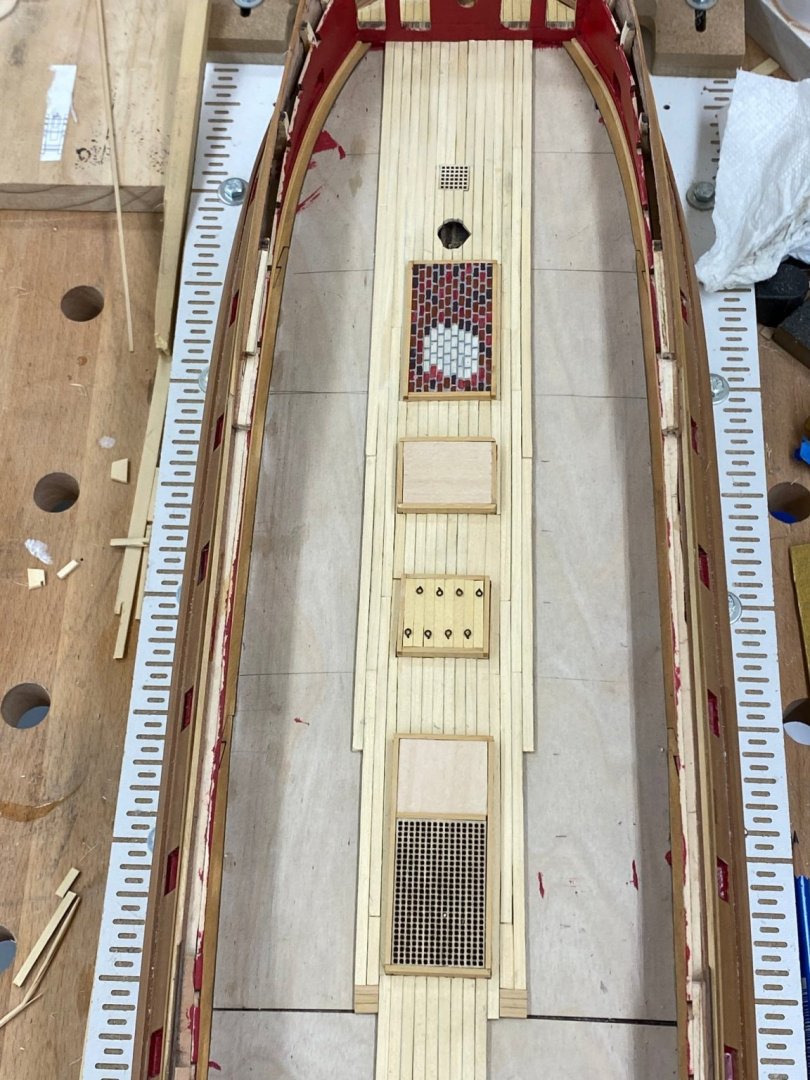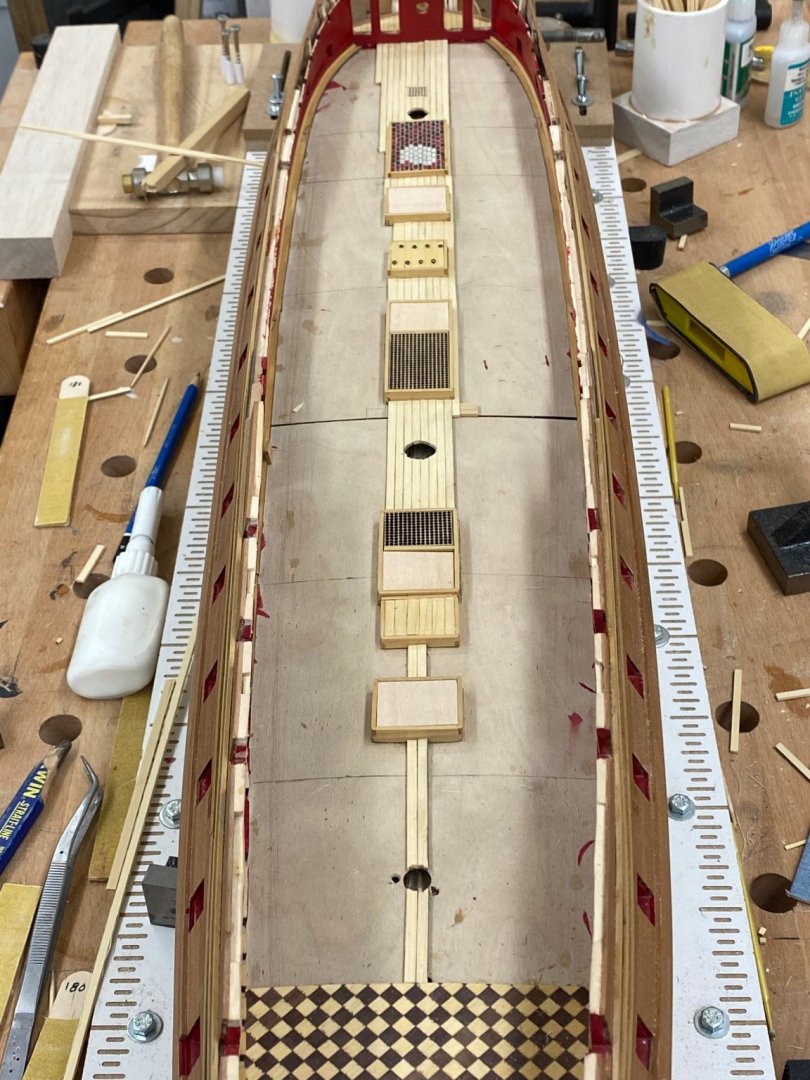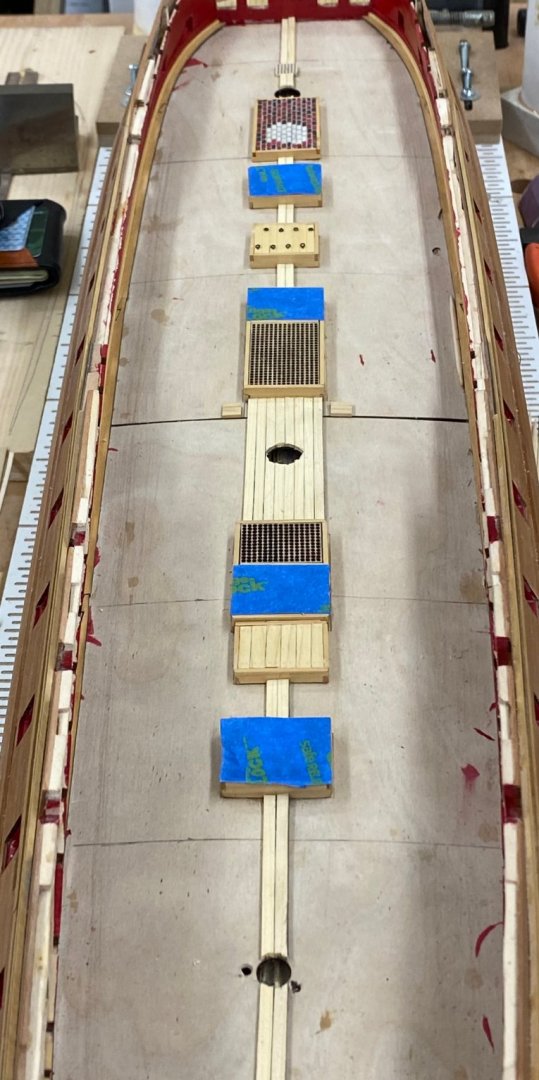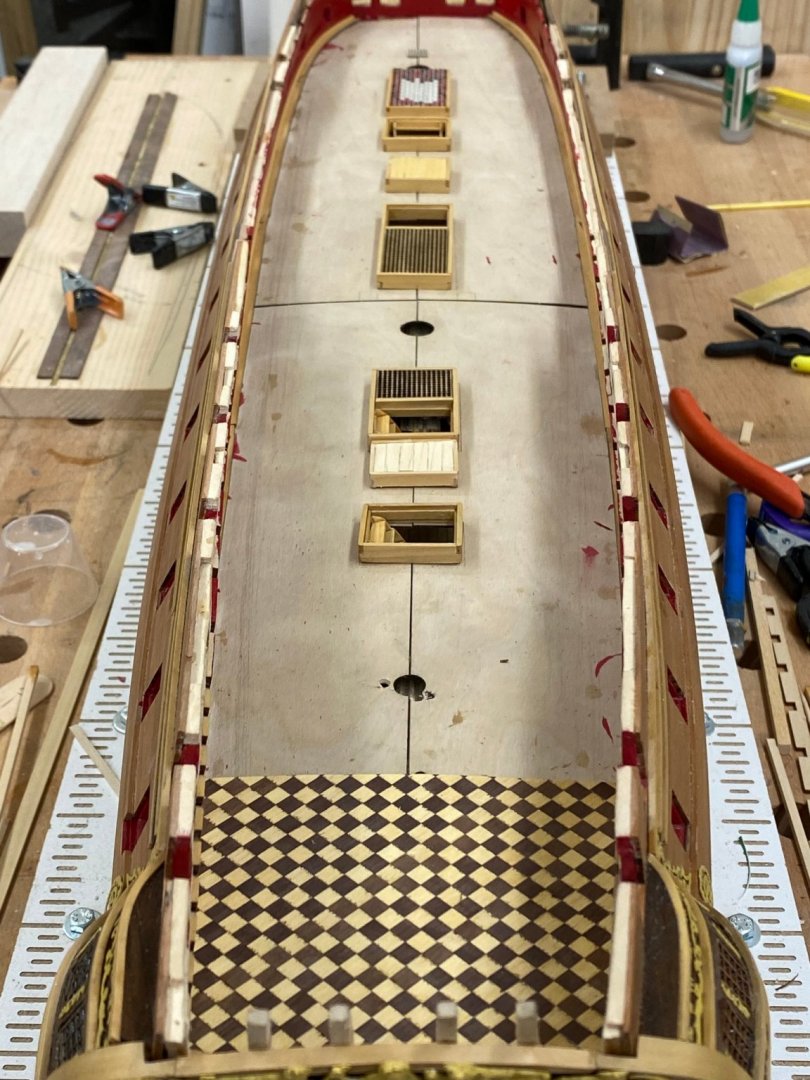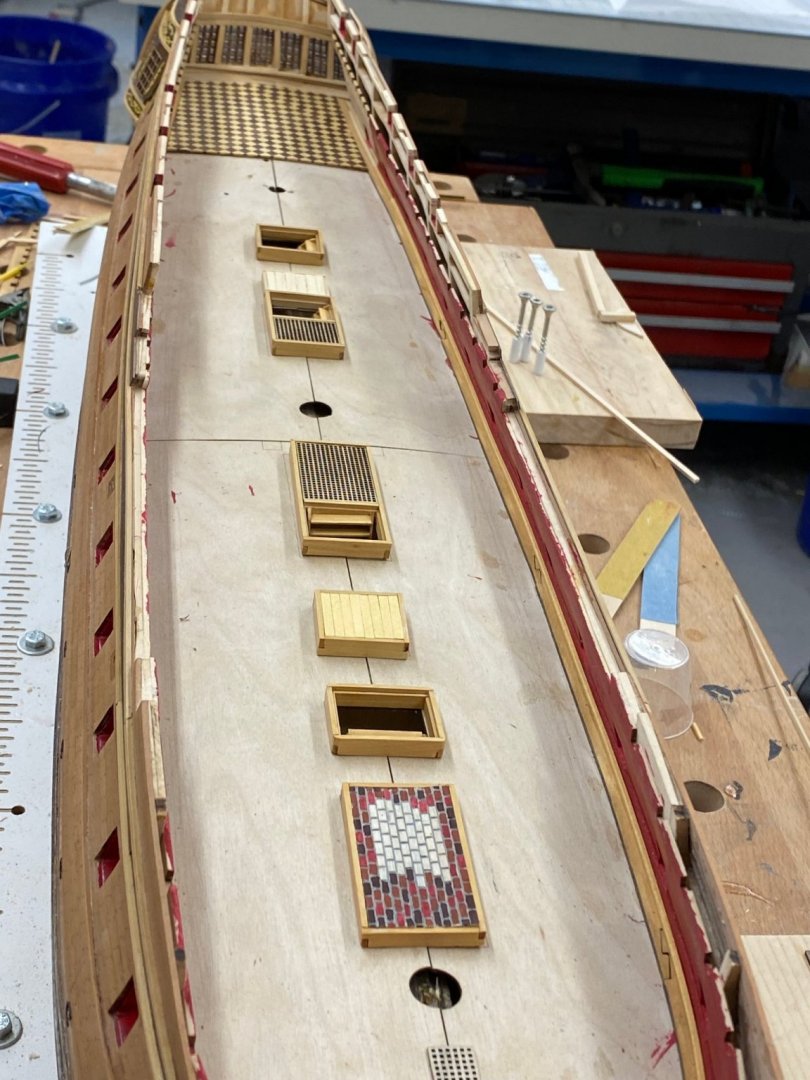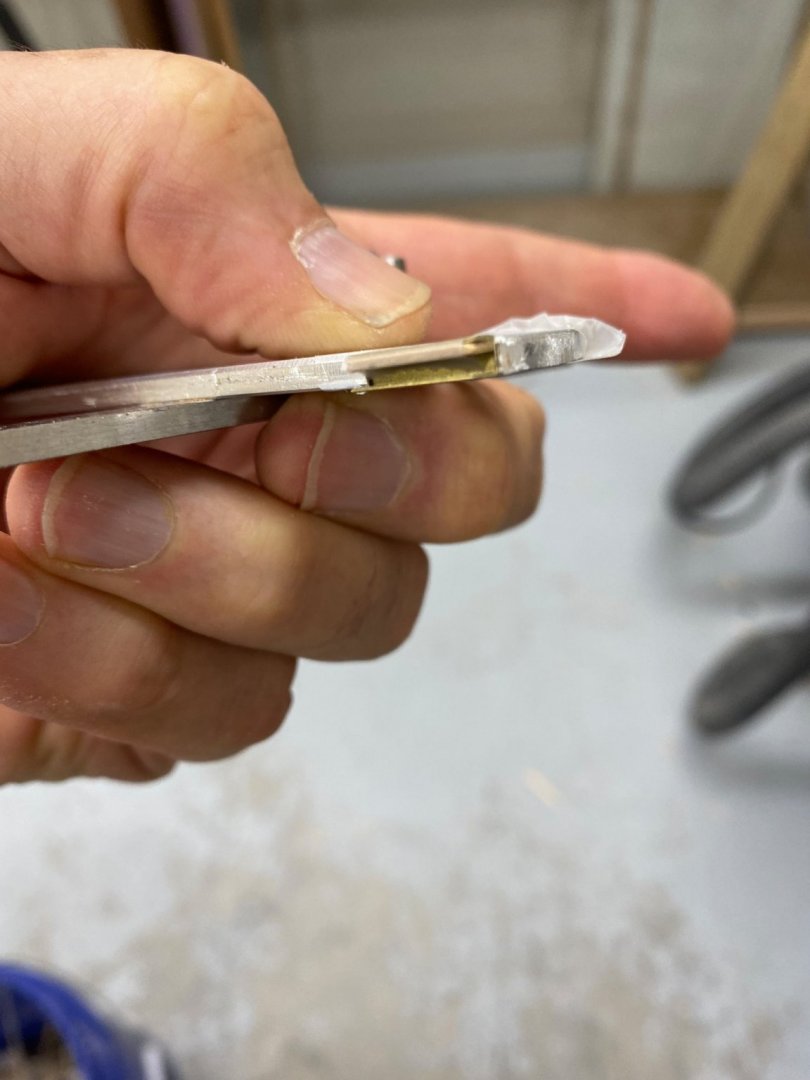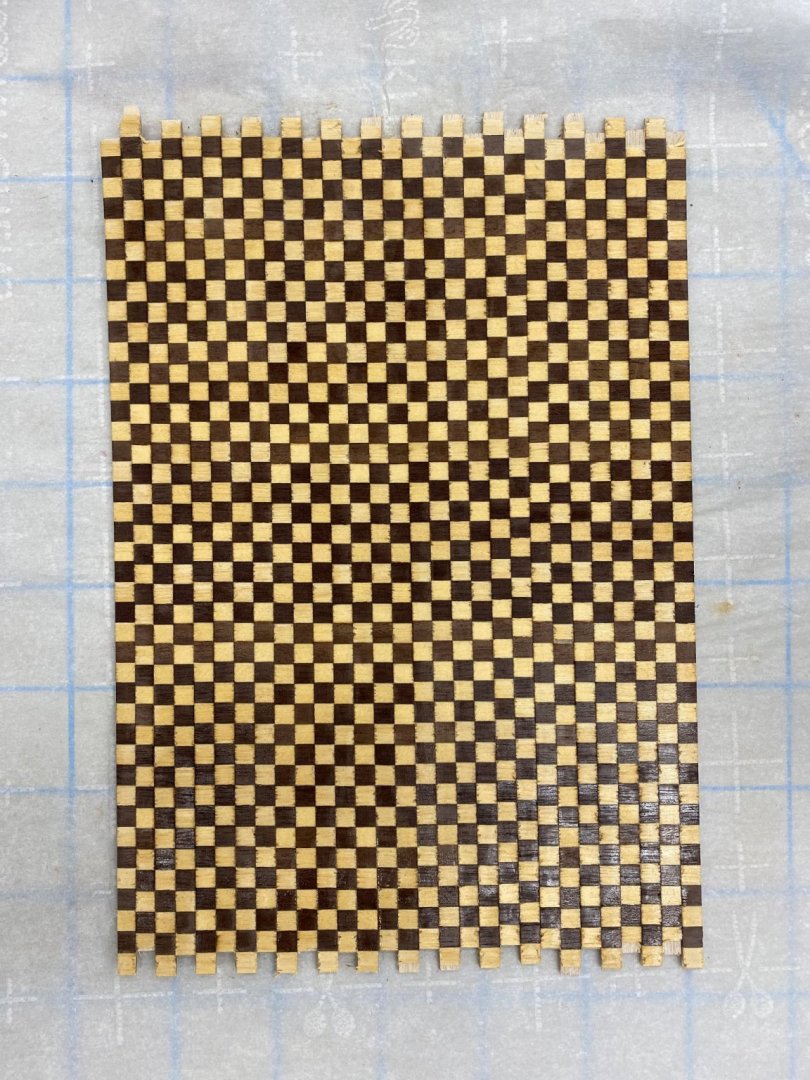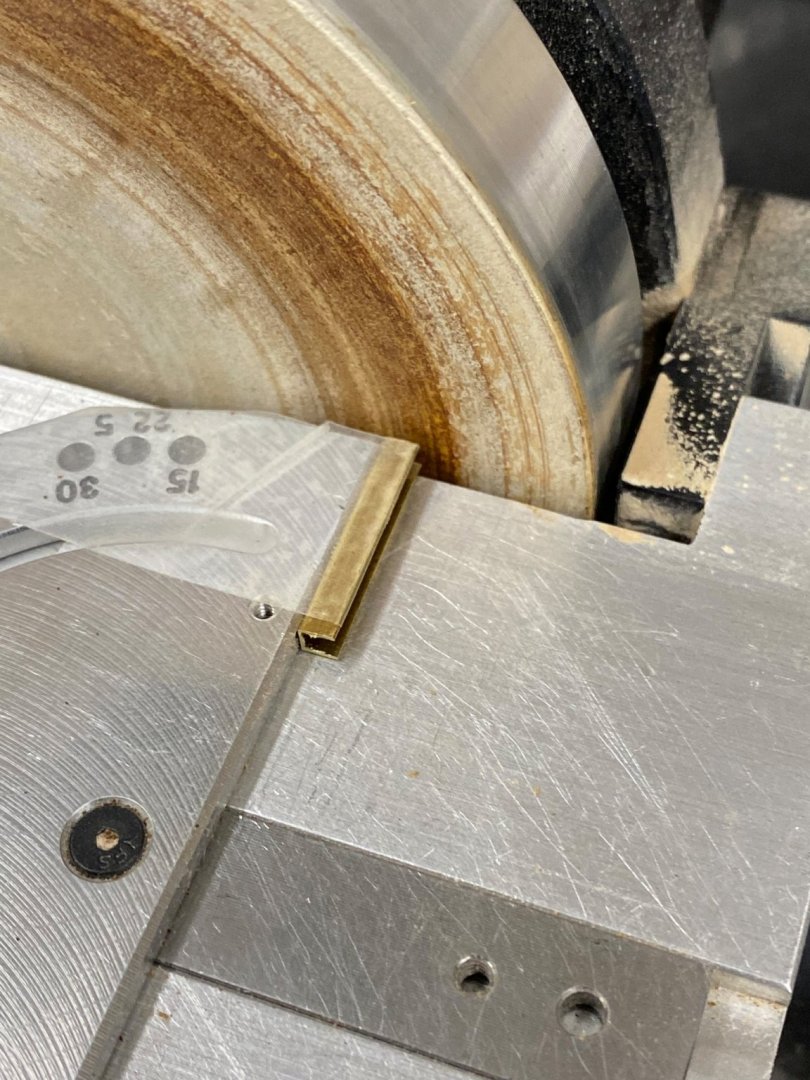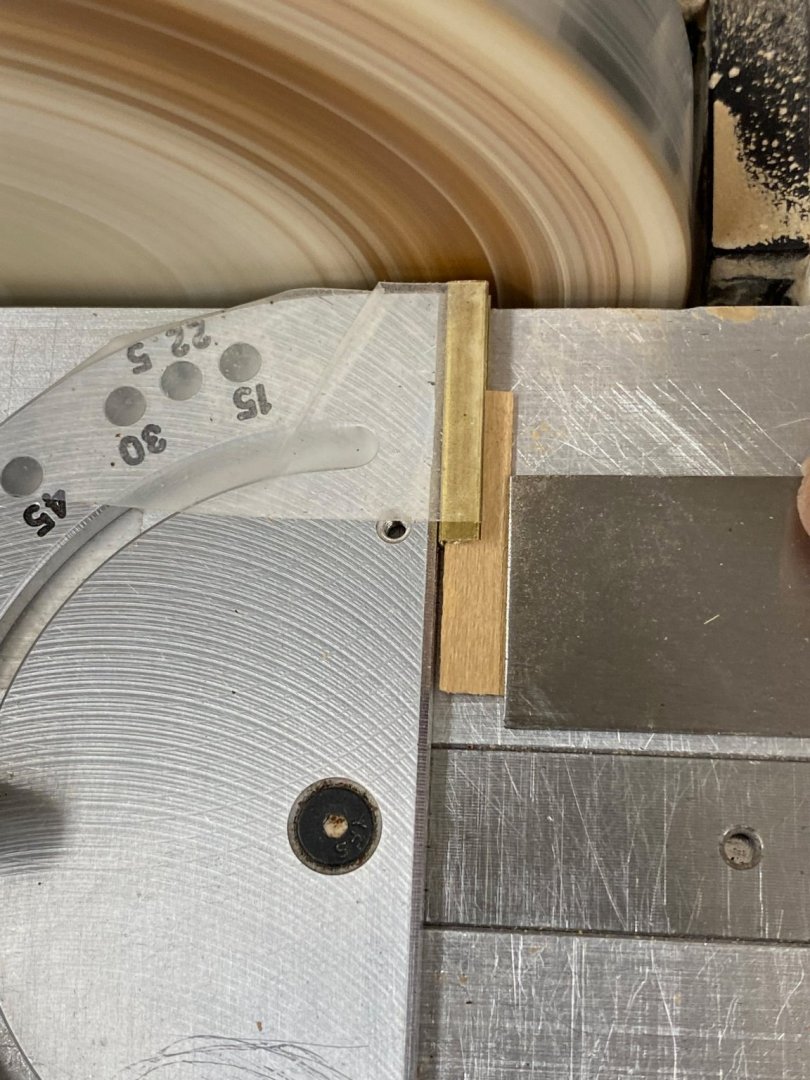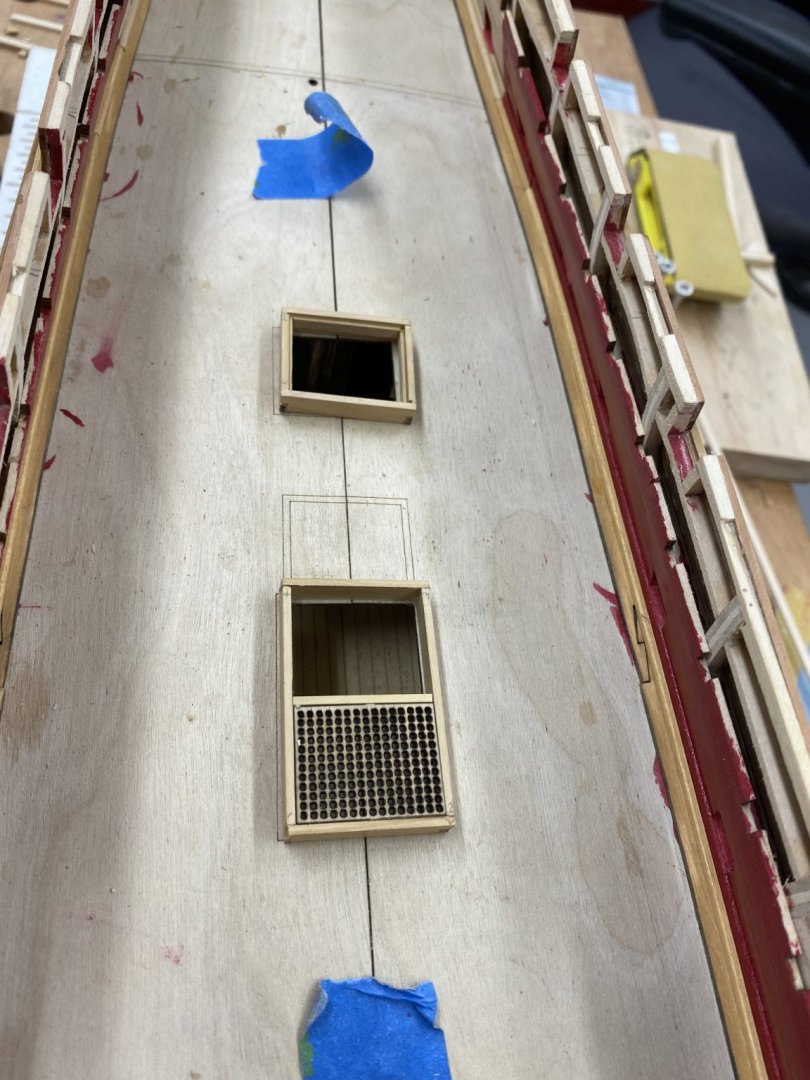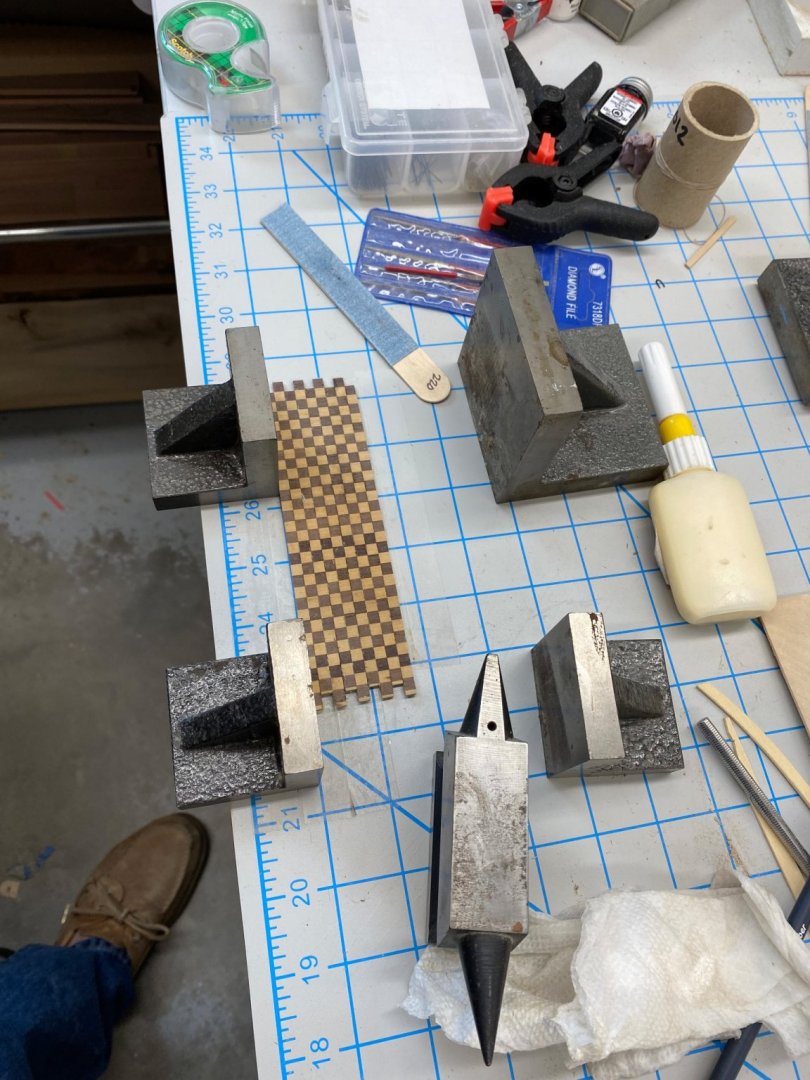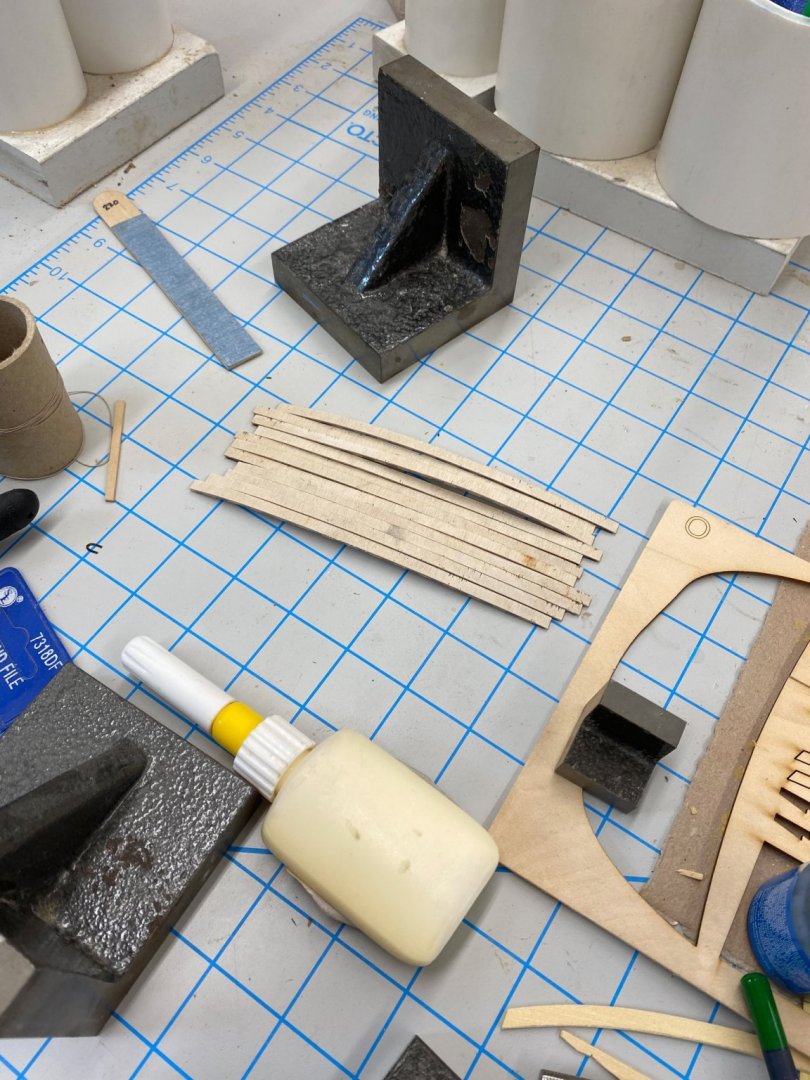-
Posts
1,915 -
Joined
-
Last visited
Content Type
Profiles
Forums
Gallery
Events
Everything posted by cdrusn89
-
I have been working on the gun carriages rather than the treenailing as I need to decide on a course going forward. Treenailing will still be there. I found at least part of the problem is with the model. According to the plans the top of the midships gun ports should be about 16mm above the deck. as you can see below mine are more like 13 or 14. Sorry about the orientation - it comes out this way no matter what the target file looks like. So I built the three smaller size carriages: the Syren 1 11/64ths and the two that came with the kit. The larger of the two carriages that came with the kit was about the same as the larger Syren carriage. It is just too tall. See below: Youi can see the gun has to be depressed to get it in the gun port. The 1 11/64s carriage did fit - just. If I go this way I will have to be careful with the thickness of the stool bed to allow space for the quoin (or leave it out). Here is what a cannon looks like from inside and out. The smaller kit provided carriage also fits; better than the Syren one but since it is made from basswood I will probably opt for the 1 11/64ths Syren carriages assuming I can get enough. I have one set of four on hand and will build those while I wait for more to arrive.
- 370 replies
-
- Model Shipways
- Confederacy
-
(and 1 more)
Tagged with:
-
I hesitate to even mention what I discovered more or less by accident yesterday. For some reason I put one of the completed cannon on the deck and to my horror found that the cannon was too tall, by about the width of the barrel to fit through the gun port!!!! Investigation revealed that I had used a cannon (1 29/64ths) that is very close to the one that came with the kit ( 1 3/8s aka 1 24/64ths) but used the Syren carriage for their larger 1 23/32 cannon. My bad!!! I have samples of all three of the Syren carriages and for whatever reason the kit came with two sets of carriages for the provided cannon. I took measurements (in mm for simplicity) of the height of the front of the carriage on all five sets using the digital calipers and here is what I found: Syren 1 23/32" - 11.56mm Syren 1 29/64" - 9.83mm Syren 1 11/64 - 7.69mm Kit # 1 - 7.74mm Kit #2 - 6.99mm So, while the cannon provided with the kit match (pretty close) the 1 29/64s Syren cannon the carriages are closer to the 1 11/64" carriages. So I am going to build a carriage in each of the three smaller sizes (I already know the largest is too big) and then decide what path to take. While I really like the Syren carriages I noticed that they are no longer made of boxwood but are now Alaskan cedar. Since they are painted I am not sure this really matters but the same could be said for the kit provided carriages. I will press on with treenailing the deck while building the carriages.
- 370 replies
-
- Model Shipways
- Confederacy
-
(and 1 more)
Tagged with:
-
Thanks WalrusGuy. I am sure yours will be at least as beautiful. And to think most of this deck is going to be under the forecastle/quarter decks. I almost chickened out of doing the treenailing but put in one row of the holes last night to reinforce my resolve.
- 370 replies
-
- Model Shipways
- Confederacy
-
(and 1 more)
Tagged with:
-
Port side deck planking completed. Now the fun. Sanding (Not!). I have decided to drill the holes for the gun tackle and breeching rope before I bother to finish (aka poly) the deck. In fact I am going to try and install all of the other "hardware" that goes on the interior bulwarks before I enbark mon the next most tedious task - treenailing. I would wait to sand the deck until I got the treenails installed but my experience is that the filler gets in all the places you do not want it and sanding it out can be problematic if the surface isn't as smooth and flat as you can get it (within reason of course). So here is the port side decking.
- 370 replies
-
- Model Shipways
- Confederacy
-
(and 1 more)
Tagged with:
-
With the prospect of having to mount the 12 pounder cannon in the near future (and looking for something to break up the next part of the decking job (treenailing) I thought having a way to secure the cannon to the deck (more secure than glue since both the cannon wheels and deck will have a coat or three of poly on them) would be useful. So I pulled out the cannon and decided that there wasn't enough "meat" to support a wooden "pin" so I decided to use metal. Phosphor-bronze since that is what I have on the shelf. I drilled a #61 hole in the front axle. Not too deep just deep enough to hold the wire with a drop of CA. Add the wire and cut. I did two of the 28 to prove the first was not a fluke. I realize that if someone were to look through the gunports at deck level that they will probably be able to see the pins but I doubt anyone I know would bother.
- 370 replies
-
- Model Shipways
- Confederacy
-
(and 1 more)
Tagged with:
-
I finished the gun tackles - eventually made 62 of them. I am sure one (at least) of the hooks will break off or some other malady afflict a few of them. If not I have enough extra to do a few of the quarterdeck cannon. Here are the last 13 of them hung over the power tool bench.
- 370 replies
-
- Model Shipways
- Confederacy
-
(and 1 more)
Tagged with:
-
Yes Ron you can do it too. I find this somewhat tedious but then rigging even a two masted square rigger also has it moments of tediousness. It could have been worse; if I remember correctly the Niagara kit had four sets of tackle (plus the breeching rope) on each of the 20 guns. At least on Confederacy there is essentially no rigging once the guns are done.
- 370 replies
-
- Model Shipways
- Confederacy
-
(and 1 more)
Tagged with:
-
I took a break from deck planking to work on the gun tackle. I need 56 (28 * 2) sets of tackle for the 12 pounders - (I will deal with the smaller gun tackle later). The breech lines are already attached to the cannon so these are the tackle used to bring the gun back to the bulwark in preparation for the next firing. These are the block with becket that attaches to the upper of the two eyebolts (yet to be installed) on each side of the gunport. The breeching tackle attaches to the lower eyebolt. I have already made the 56 single blocks that are attached to the gun carriage. I used Model Expo "Beautiful Blocks" 2.5mm singles. I decided to strop them with 34 gauge wire instead of line because I find that easier to do (no glue required) and I have not had great luck making (and successfully attaching) small wire (brass or steel) hooks to small single blocks. The instructions would have you make the blocks from scratch and they made it easier to get the hook enough material to glue to by only putting a single hole for the line. I have about 30 completed and have the hanging over the plans to try are get some of the twist out of the line. Here is a close-up of a few of them. I am not real proud on the consistency of the hook but since it will be up against the bulwark I doubt it will be really obvious.
- 370 replies
-
- Model Shipways
- Confederacy
-
(and 1 more)
Tagged with:
-
Starboard side deck planking is complete. I sanded this side some but will wait to get the planking completed before doing the "serios" sanding. Hook scarf took some planning but i think I did it correctly. Probably a wash from a difficulty standpoint between hook scarf and nibbling. You have to do nibbling more often but it is generally relatively easy and quick. It seems I spent quite a bit of time sanding the 1/4" planks to fit along side the waterway. I also (finally) set the table saw to ensure I had an 1/8" piece after the scarf. That helped keep the scarf "leg" the same width as the rest of the planking. So here is where we stand at the moment.
- 370 replies
-
- Model Shipways
- Confederacy
-
(and 1 more)
Tagged with:
-
I have the deck planking completed (installed not "finished") for a width of 16 planks from bow to stern. I had to use a apprx 1/16" wide strip at the stern (abaft the mizzen mast) to get the sides to "match up" so I could run the full width strips down each side. Given the variation in the width of the planking strips and coamings it would probably have been a fool's errand to expect everything to work out evenly. Here is where the deck planking stands at the moment.
- 370 replies
-
- Model Shipways
- Confederacy
-
(and 1 more)
Tagged with:
-
- 370 replies
-
- Model Shipways
- Confederacy
-
(and 1 more)
Tagged with:
-
Bruce, I used the Syren brass cannon. I used a drill press to drill a hole in the cannon (before painting them flat black) and glued in an eyebolt (from Model Expo) for the breech rope.
- 370 replies
-
- Model Shipways
- Confederacy
-
(and 1 more)
Tagged with:
-
Bruce, I assembled all the cannons before I started the hull. I have all the breech tackles ready to install too and some (but not nearly all) of the gun tackles. I plan on periodically taking a break from the deck planking to get the rest of them ready.
- 370 replies
-
- Model Shipways
- Confederacy
-
(and 1 more)
Tagged with:
-
I got the planking between the four forward-most hatch coamings extended outward enough to start the planking scheme on both sides. I am going to stop in the forward section and get the after section in a similar state before proceeding with extending the planking to the waterways. Here is where things stand at the moment.
- 370 replies
-
- Model Shipways
- Confederacy
-
(and 1 more)
Tagged with:
-
Continuing with the deck planking. I had to resort to some wider planks to try and get them to come out "even once clear of the coamings. Looking at the plans (sheet 1) shows that all but one of the coamings should be exactly 10 planks wide. If I had looked earlier I would have tried harder to get them a consistent width. I also got tired on the blue tape on the ladder wells so I cut some 1/32" sheet to fit them and replaced the tape. I have the starboard side forward extended to the first row outside the coamings. Will get the port side in a similar condition before moving aft of amidships. Here is an overall view and a closeup of the main hatch way where I have glued down the small hatch cover and the wider planks I used.
- 370 replies
-
- Model Shipways
- Confederacy
-
(and 1 more)
Tagged with:
-
Working the area between the coamings. I decided not to worry too much about having the planking exactly match the curve of the mast holes as this will be covered by the mast coats. It appears that I am going to have to make some notched planks to fit around some of the coamings. It was probably too much to hope for that I had made the coamings an even multiple of the plank widths wide. I also decided to cover the hatch openings to keep any debris from ending up down there. With the ladders installed getting it out might be a challenge. So here is where the planking stands.
- 370 replies
-
- Model Shipways
- Confederacy
-
(and 1 more)
Tagged with:
-
Thanks Tim. I finally got the Alaskan Yellow Cedar planking sheets from Syren Ship Model and am in the process of ripping them into 1/8 X 1/16 strips for planking the deck. I also made some 1/4 X 1/16 planks for (hopefully) the hook scarfs that are in the future. Here is my "stash" of cedar planks ready to "meet the deck".
- 370 replies
-
- Model Shipways
- Confederacy
-
(and 1 more)
Tagged with:
-
I finally got all the items completed prior to adding the deck planks on the gun deck. I am waiting for more Alaskan Yellow Cedar from Syren Ship Model Company from which to mill the 1/8" X 1/16" deck planks plus some wider (probably 1/4" X 1/16" to accommodate the "hook scarfs" used at the edges. I have not done this before - all my previous experience with with the nibbling technique but on hulls that did not have a false deck. Cutting the nibs into the margin plank is significantly easier if there is no false deck to interfere with getting access to the edge of the margin plank. So here is the model with the gun deck items glued down, except the two small gratings. I noticed that my main hatch coaming is not quite as wide as the outline on the false deck (although it does fit the provided grating so...) so I will wait until I have some decking installed in the area to glue them down. I don't want to have to create a very narrow plank to go between these small gratings and the main hatchway.
- 370 replies
-
- Model Shipways
- Confederacy
-
(and 1 more)
Tagged with:
-
I finished the coamings and associated gratings and ladders. I put a coat of clear flat on everything but the capstan platform (need to add the treenails before adding finish). Here are all the centerline "fixtures" sitting in place along with the checkerboard flooring glued down and the stern lights replaced. I decided to only paint the bricks where they will show although I have painted a few more since I took this picture and added the eyebolts to the forward hatch. I
- 370 replies
-
- Model Shipways
- Confederacy
-
(and 1 more)
Tagged with:
-
After a good bit of sawing and even more sanding I got the checkerboard floor to fit and meet the dividing line that I drew in (about 1mm forward of the one etched in the false deck). I even managed to get the points of the checkers to all start at the front. It is not really "perfect". There are small bits of the next row of diamonds near the center but considering all that it took to get this done I am going to call this a "success". Sadly much of the forward most part will be hidden by the bulkhead that marks the start of the great cabin - but I'll know it is there.
- 370 replies
-
- Model Shipways
- Confederacy
-
(and 1 more)
Tagged with:
-
I got the "checkerboard flooring completed (second time) using an 8" X 8" square this time. So I took my template and trimmed it to fit in preparation for cutting/shaping the flooring. I decided to sand and apply a few coats of WoP before trying to cut/sand the flooring. The cedar I used for the light color has a tendency to splinter when cut on the table saw, even with a 100 tooth slitting blade. Hopefully the poly will help to prevent that. I do not intend to cut very close (no closer than 1/2") to the template line and use the disk sander to take off the rest. Here is the template in its "final" form. I will put the stern lights back in when I get the flooring installed. While cutting the steps for the ladders the run athwartship I made an addition to the template I showed in the previous post. I glued a piece on 1/32" planking into the brass channel to keep the plank being sanded from moving up (although the disk rotation should make this unlikely) when pressed against the disk. Here is a shot with that addition.
- 370 replies
-
- Model Shipways
- Confederacy
-
(and 1 more)
Tagged with:
-
Allan, My girlfriend bought that digital level for me last Christmas (from MircoMark I believe). I have a level "app" on my iPhone but it is usually too big to get where I need it so the small one comes in handy. You can never have too many tools. ---------------------------------------------------------------------------------------------------------------------------------------------------------------------------------------------------------------------- So while waiting to rebuild my checkerboard flooring I decided to start on the ladders. It seems that some of them run fore/aft while the two aft ones run from stbd to port which means there are going to be at least two different lengths for the planks that will form the steps. And given that there are eight steps per ladder it is going to be important that the steps are the same length - as exactly as can be managed. I started with the longer steps for the fore/aft ladders. I cut some 1/32" X 3/16" boxwood to a bit longer than required and then cut a piece of brass channel to the desired length. I used Scotch tape to attach the brass channel to the mitre gauge on the disc sander as shown below: I use the brass channel as a guide and a small T-square behind the the plank to push the plank against the sanding disc until the t-square is against the end on the brass channel. It is hard to get a picture of the exact placement of pieces since it takes two hands - one holding the t-square and the other holding the plank against the channel. So no hand for the camera. Anyway here is the result: Not perfect but as good as I know how to make them. Now back to the checkerboard flooring.
- 370 replies
-
- Model Shipways
- Confederacy
-
(and 1 more)
Tagged with:
-
For whatever reason my first attempt at creating the checkerboard great cabin floor did not turn out so great. The distinct curvature that the strips assumed after being cut out from the sheet with the alternating rows of walnut and boxwood made it difficult to make a good joint between successive rows. And it appeared that the 6" X 6" square was not going to produce enough material to support using the 45 degree slanted "architecture" shown in the plans. So I decided to give it another try. This time I cut an 8" X 8" piece of 1/32" plywood and decided to glue the strips to the "other" side.i.e. the side I did not glue the strips to the first time. I also used the machinist blocks to hold the material flat while the glue cured. This seemed to reduce the amount of curvature to a considerable degree and made cutting the strips for the decking much easier. I also decided to cut a strip, glue it to the "stack" immediately, then wait 10 -15 minutes before cutting another strip. In my previous attempt I cut all the strips at one sitting and then started to glue them into the decking piece at a leisurely pace. I think the strips took on even more curvature after they were cut from the main piece. So here is the new set of strips on the 8" X 8" piece of plywood. And this time I used Alaskan Cedar instead of boxwood with the kit provided walnut. I think the cedar will provide more contrast with the walnut and I intend to plank the gun deck in Alaskan cedar. While waiting for the pieces to set in the deck planking piece I worked on the hatches. I decided to use boxwood for these as it cuts much better than basswood and making the end joints can be done with a Xacto chisel blade and a small file for fine adjustments. So far I have the first companionway hatch and two thirds of the next hatch assembly moving forward. Here are the rough hatches, before the corner rounding and WoP finish.
- 370 replies
-
- Model Shipways
- Confederacy
-
(and 1 more)
Tagged with:
-
While waiting for the bulwark paint to dry I started on assembly of the great cabin checkerboard flooring. I gave some thought to looking at the doll house shop that is half a mile away to see if they had something that might be easier to use - like simulated kitchen flooring or something of a similar size but keep forgetting so I will follow the instructions, for now. Gluing up the 1/32" walnut and boxwood (my choice) was not a problem. However, the instructions said to glue them to a 6" X 6" sheet of 1/32" plywood which I was unable to locate. Luckily I had some in the "wood pile" so cut a 6" X 6" piece and used it. Maybe my plywood is not of the same quality as what supposedly comes in the kit or it is really humid in the workshop because when I took the weights off the entire square bowed up almost .5" at one side. When I cut the 3/16" strips they warped even more. In the photo below the group of strips closest have had the angle block on top of them all night. The three further back are some that did not get that treatment. So I had to create a way to hold the strips flat while squeezing them together while the glue (carpenters yellow glue) sets up. I used some of the machinist's angle blocks and an anvil after putting down strips of Scotch tape down on the cutting mat so the glue would not stick (too much). I use four of the blocks to press the newly added strips (I add two at a time) to the already dried pieces, a block on each end to hold all the pieces flat and the anvil (on top of a sanding stick) to hold the two new strips down. I wait at least an hour before adding another two strips. Here is the "assembly" waiting for the glue to set-up.
- 370 replies
-
- Model Shipways
- Confederacy
-
(and 1 more)
Tagged with:
About us
Modelshipworld - Advancing Ship Modeling through Research
SSL Secured
Your security is important for us so this Website is SSL-Secured
NRG Mailing Address
Nautical Research Guild
237 South Lincoln Street
Westmont IL, 60559-1917
Model Ship World ® and the MSW logo are Registered Trademarks, and belong to the Nautical Research Guild (United States Patent and Trademark Office: No. 6,929,264 & No. 6,929,274, registered Dec. 20, 2022)
Helpful Links
About the NRG
If you enjoy building ship models that are historically accurate as well as beautiful, then The Nautical Research Guild (NRG) is just right for you.
The Guild is a non-profit educational organization whose mission is to “Advance Ship Modeling Through Research”. We provide support to our members in their efforts to raise the quality of their model ships.
The Nautical Research Guild has published our world-renowned quarterly magazine, The Nautical Research Journal, since 1955. The pages of the Journal are full of articles by accomplished ship modelers who show you how they create those exquisite details on their models, and by maritime historians who show you the correct details to build. The Journal is available in both print and digital editions. Go to the NRG web site (www.thenrg.org) to download a complimentary digital copy of the Journal. The NRG also publishes plan sets, books and compilations of back issues of the Journal and the former Ships in Scale and Model Ship Builder magazines.



